
Welcome to the 150th Running of the
Kentucky Derby!
Enjoy learning about the previous 149 Derby Winners, their stories, their race, and more!
1875
Aristrides 2:37.75
(1872–1893)
In 1875, the Derby was raced at a mile and a half, the distance it would remain until 1896, when it was changed to its present mile and a quarter.
A life-sized bronze statue of Aristides stands in the Clubhouse Gardens as a memorial.


1876
Vagrant 2:38.25
(1873–c.1890)
Vagrant was the first of nine geldings to win the Kentucky Derby.
Vagrant was widely rumored to have been a vegetable cart horse in Lexington after his racing career, having been sold into this service sometime after 1883.
1877
Baden-Baden 2:38
(1874-?)
This chestnut stallion was known for coming from behind for the win!
Injury ended Baden-Baden’s racing career; he was retired to stud duty at William Astor’s Ferncliffe Stud, where he sired many offspring.


1878
Day Star 2:37.25
(1875–1893)
This chestnut stallion led the race from start to finish to create a huge upset in the Derby.
A 1910 Daily Racing Form article states that Day Star was sold after his racing career and stood at stud on a western farm, dying at the age of 18 years in 1893.
1879
Lord Murphy 2:37
(1876 – after 1881)
This bay was knocked almost to his knees on the first turn but fought back to finish first in the Derby.
He acquired a “savage” temper and became a “roarer” He was later sold at a British public auction in Newmarket fetching a small sum of 10 guineas ($50).


1880
Fonso 2:37.50
(1877 – 1903)
This chestnut stallion kicked up the dusty track to obscure the path for the other horses to finish first in the Derby.
Fonso was described as “a very neat, wiry colt.” He had a rather short neck, a good shoulder, and a deep girth. A photograph taken of the horse during his stud career suggests that he had a dipped top line and an unusually straight hind leg. He was good-natured but inclined to be lazy.
1881
Hindoo 2:40
(1878 – 1901)
At the Derby, this bay stallion took the lead. Then, at the halfway pole, Lexex took the lead. As the horses went into the turn, Hindoo regained the lead, and when he entered the stretch he was in command and won by four lengths going away.
Hindoo was never out of the money winning thirty times, placing second three times, and showing third twice. As a three-year-old, he won the 1881 Kentucky Derby in a season where he recorded eighteen straight wins over the course of a few months-nineteen if a dead-heat run-off on the same day counts. Over the course of his racing career, he won $71,875, making him America’s leading money earner. He was one of the first handful of horses inducted into the National Museum of Racing and Hall of Fame in 1955.
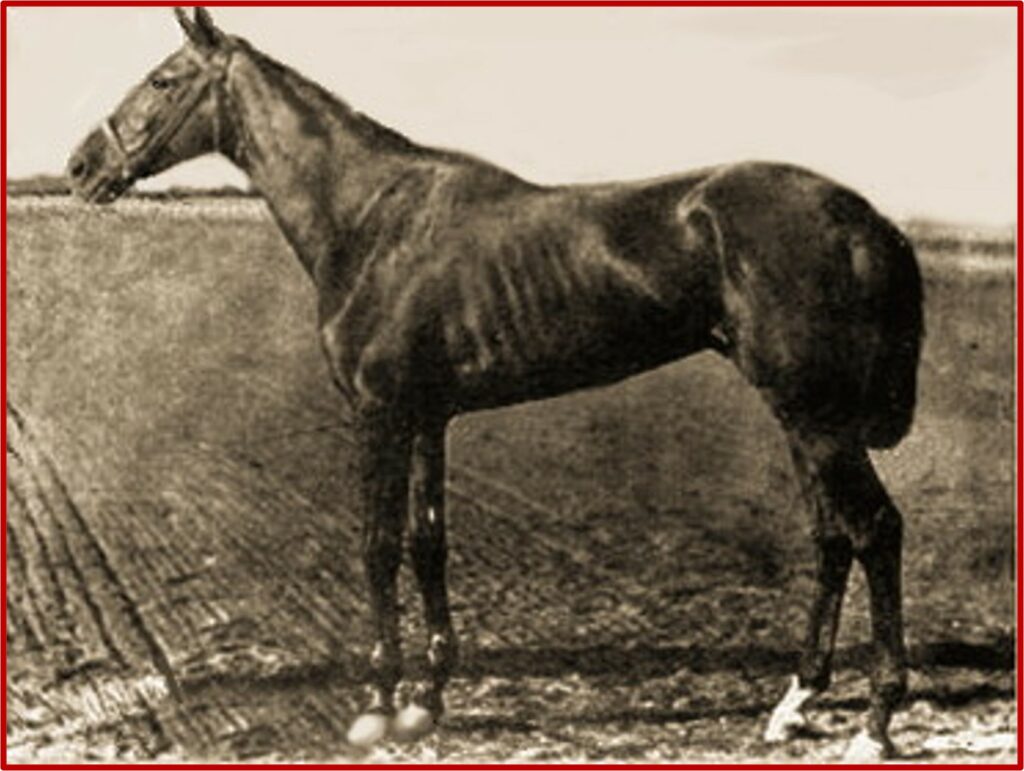

1882
Apollo 2:40.25
(1879–1887)
The chestnut stallion, Apollo broke near the back of the pack but worked his way up to sixth after a mile. Turning into the stretch, Runnymede made his move and took the lead in deep stretch, looking the likely winner. However, Apollo closed with a “cyclonic rush” and caught up in the final strides, winning by half a length.
Apollo was injured as a five-year-old and was retired from racing. He was given to a friend of Morris’ wife that lived in Charleston for use as a saddle horse. He died in November 1887 of lockjaw.
1883
Leonatus 2:43
(1880–1898)
The track, hit by a deluge of rain, making it a sea of mud, resulted in the only weather-related time in its history, that the Derby was postponed a day. Running in mud on a clear, cold day, the colt Drake Carter leaped into the lead, but Leonatus caught him at a quarter of a mile. A quarter of a mile farther on, Leonatus was ahead by three lengths. In the homestretch, Lord Raglan made a strong bid, but he tired. Leonatus won over Drake Carter by three lengths.
Leonatus ate the presentation roses; blankets of roses were not yet used. Leonatus lies in an unmarked grave on a bend of the Elkhorn Creek that runs through Runnymeade Farm.


1884
Buchanan 2:40.25
(1881–1898)
The jockey didn’t want to ride “the wildest horse in America” the chestnut stallion, Buchanan, who had never before won a race, and bolted in his prior start in Nashville. The Louisville Jockey Club judges ruled that if the jockey did not honor his commitment to ride Buchanan, he couldn’t ride at all that day. Buchanan acted up in the post parade and got away poorly. But the jockey saved ground for three-quarters of a mile before getting Buchanan to the outside, from where he swept to the lead for a length victory over Loftin.
Buchanan known as a difficult and unruly mount retired from racing at age three and worked as a stud, finally dying after a sudden illness of inflammation of the bowels.
1885
Joe Cotton 2:37.25
(1882–c.1900)
The track, hit by a deluge of rain, making it a sea of mud, resulted in the only weather-related time in its history, that the Derby was postponed a day. Running in mud on a clear, cold day, the colt Drake Carter leaped into the lead, but Leonatus caught him at a quarter of a mile. A quarter of a mile farther on, Leonatus was ahead by three lengths. In the homestretch, Lord Raglan made a strong bid, but he tired. Leonatus won over Drake Carter by three lengths.
Leonatus ate the presentation roses; blankets of roses were not yet used. Leonatus lies in an unmarked grave on a bend of the Elkhorn Creek that runs through Runnymeade Farm.

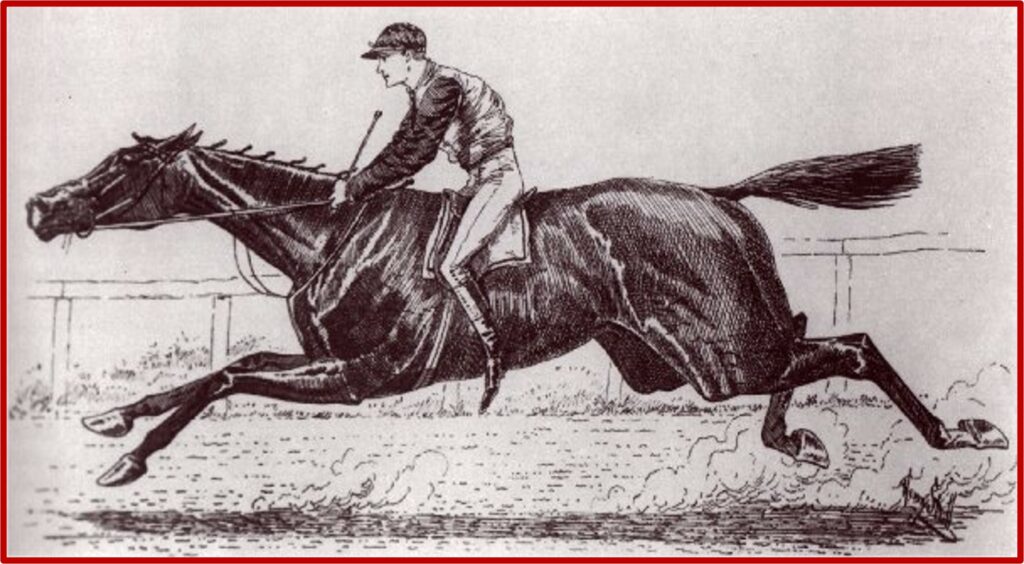
1886
Ben Ali 2:36.25
(1883–c.1903)
All horses had a good start, with the bay stallion, Ben Ali, staying bunched in the pack for most of the race. Entering the home stretch, he was second behind Free Knight with Blue Wing third. The trio battled it out, with Ben Ali and Blue Wing continuing to duel at the furlong pole. At that point, Blue Wing swerved to the outside, allowing jockey Paul Duffy to ride Ben Ali to victory on the rail, taking the race by half of a length. The race was called by the New York Times, “the grandest Derby ever run”.
This Derby race led to a boycott because the wagering rights changed under new ownership, thus there were no bookmakers at the race. Ben Ali’s owner was not able to place a bet on his horse and was treated poorly by the new owner. The treatment of the horse owners caused a nationwide boycott of the Kentucky Derby, nearly causing Churchill Downs to close.
1887
Montrose 2:39.25
(1884–1898)
The bay stallion, best known for winning the Derby, Montrose, also reportedly won a large sum of money for his owners – the Labold brothers – who made $20,000 off the horse’s win through purse and gambling winnings.
The horse died at age 14.
Leonatus ate the presentation roses; blankets of roses were not yet used. Leonatus lies in an unmarked grave on a bend of the Elkhorn Creek that runs through Runnymeade Farm.


1888
Macbeth II 2:38.25
(1885-?)
The bay thoroughbred was the third of just nine geldings to win the Kentucky Derby.
As a three-year-old, Macbeth II stood 15.2 hands high. Gallifet and The Chevalier were clear contenders from the start of the race, with Macbeth not gaining a lead until a mile into the race. He won by a length over Gallifet. Macbeth II, being a gelding with no possible career at stud, raced until he was eight years old.
He was eventually hampered in racing by an illness in the winter of 1888–1889. As an older horse, he was used for training new exercise riders due to his gentleness before being retired as a saddle horse.
1889
Spokane 2:34.50
(1886-?)
The chestnut thoroughbred stallion is the only horse foaled and trained in Montana (territory at that time). Montana was admitted to the Union that same year.
Spokane got on the rail and closed in the stretch to the cheers of the crowd to win by a nose in the final strides. In a time before photo finish, it was left to the judges who awarded the win to Spokane after deliberation.
After spending a few years as a stud, in 1898, he was sold at auction for the low price of $170.
The later years of Spokane’s life are unknown. Some records indicate he returned to Montana at age six, some that he was fatally stabbed by a pitchfork, or died in a railway accident, or died peacefully at age 30 in Montana.


1890
Riley 2:45
(1887–1910)
The bay stallion, best known for winning the Derby with the slowest time recorded to that point due to a very muddy track.
The horse died at age 23 while being cared for by a racehorse rescue.
1891
Kingman 2:52.25
(1888–1893)
The bay stallion, best known for winning the Derby, he holds the slowest time recorded.
The horse died at age 5.


1892
Azra 2:41.50
(1889–1909)
The bay stallion, standing 15.2 hands was a compact and tenacious horse.
He ran in the smallest race in Derby history, battling only 2 other horses for the prize. However, the spectators were treated to a thrilling show as Azra made up six lengths on his chief rival, Huron, in the stretch and battled through a desperate duel in the final furlong to win by a margin the Louisville Courier-Journal estimated as “six inches.”
Azra ended his career as a stud, though he was not very successful as a sire.
1893
Lookout 2:39.25
(1890–?)
The chestnut stallion, with three while stocking, was the 19th Derby winner.
His field of six ran on a sunny, clear day in one of the biggest racing turnouts. Lookout was the leader throughout the race, being continually pulled back by his jockey, and won by 5 lengths.
The horse was gelded and sold to the founder of Seagram Distillery. Later he was sold again, in 1898,for $65.


1894
Chant 2:41
(1891–after 1910)
The bay stallion, best known for winning the Derby, and was related to five previous Derby winners.
He was sold after the race and injured his leg in 1895. Later he was sold to a western thoroughbred breeder.
1895
Halma 2:37.50
(1892–1909)
The black stallion, best known for being the first Kentucky Derby winner to sire a Kentucky Derby winner.
He won the last Kentucky Derby to be held at the race’s original 1½ mile distance.
In 1896 he went lame and was retired to stud where he notably sired Alan-a-Dale (b. 1899), winner of the 1902 Kentucky Derby.
The Halma died at age 17.


1896
Ben Brush 2:07.75
(1893–after 1918)
The bay stallion, best known for running the first race at its current, shorter length and also the first in which a blanket of red roses were draped over the shoulders of the winner.
Having never run farther than seven furlongs in his career, he stumbled badly coming away from the barrier, nearly unseating his jockey. By the time they recovered, the race seemed over for Ben Brush, but he made a tremendous move on the backstretch, caught First Mate on the turn for home, and battled fiercely with Ben Elder down the stretch before winning by a nose. The correspondent for the “Spirit of the Times” wrote, “Simms made one last and desperate rally with Ben Brush, displaying as vigorous a piece of riding as was ever seen, and gradually but surely gaining on the other Ben, he finally beat him out by a nose in a terrific and hair-raising finish, which elicited a wild and spontaneous shout from the grandstand.”
He died at the age of 25.
1897
Typhoon II 2:12.50
(1894–?)
The chestnut stallion, best known for winning the Derby, against the odds, on a muddy track.
In 1899 he was gelded and retired. In 1903, the stable owner ordered the trainer to dispose of Typhoon II as they needed the space. The trainer gave the horse to a friend, who put him to work as a cart horse, hauling hay for livestock.


1898
Plaudit 2:09
(1895–1919)
The bay stallion, best known for winning the Derby as he came from behind with a powerful stretch drive to catch the betting favorite Lieber Karl and win by a nose.
Plaudit died in 1919 and is buried in the Hamburg Place equine cemetery.
1899
Manuel 2:12
(1892–1909)
The bay stallion, best known for winning the Derby, though it was deemed a very uneventful race.
A few days after the Derby at Churchill Downs, Manuel injured his leg by stepping in a hole in the track which prompted his withdraw from racing for the rest of the season.
He was sold and then shortly after, dies as a four year old.


1900
Lieut. Gibson 2:06.25
(1897–1900)
The bay stallion, best known for winning the Derby, setting the race record for the next 11 years.
Lieut. Gibson sustained a bowed tendon and was retired from racing. The condition progressively worsened until surgery was attempted to repair the tendon and reduce the swelling in his leg. However, the colt died during the operation on December 18, 1900.
1901
His Eminence 2:07.75
(1898–c.1906)
The bay stallion, best known for winning the Derby.
His Eminence was sold a couple of times, finally landing a career as a steeplechaser. Sadly, he was killed while trying to jump a hurdle.


1902
Alan-a-Dale 2:08.75
(1899–1925)
The chestnut stallion was named for a figure in the Robin Hood legend. According to the stories, he was a wandering minstrel who became a member of Robin’s band of outlaws, the “Merry Men.”
The official Kentucky Derby website says that Alan-a-Dale had a lead of six lengths and despite going lame down the stretch, “carried on with flawless courage to win by a nose.“
He raced for three more years, retired as a stud and died at age 26.
1903
Judge Himes 2:09
(1900–1908+)
The chestnut stallion’s entry in the Kentucky Derby remained uncertain until just 45 minutes before the race, when the owner sought out jockey Hal Booker and told him to get ready to ride.
The 1903 Kentucky Derby was the first to be started with a web barrier. Consisting of a wide tape strung between two iron arms, the barrier was set up so that it would snap up and forward out of the horses’ way when the starter pressed a button. The web barrier would be used until 1930, when the mechanical starting gate was introduced at Churchill Downs.
Judge Himes was described in post-Kentucky Derby coverage as being of “great size” and “splendid conformation”; however, later coverage described him as “homely.” He was a difficult horse to ride, possibly because of persistent heel soreness, and was known as “the old rogue” around the stable. He particularly favored heavy going. He was injured in December of his 5-year-old season and never regained his earlier form.


1904
Elwood 2:08.50
(1901–1910+)
The bay stallion, best known for being the first horse both bred and owned by a woman to win the Derby.
The thirtieth Kentucky Derby was run on a fast track with a field of five contenders. Elwood won at 15-1 odds over the favored colt, Proceeds, in one of the greatest upsets recorded at the Derby to that date.
Elwood was gelded, but continued to race until his then owner was banned from racing and sold him. Elwood was then used as a saddle horse.
1905
Agile 2:10.75
(1902–1914+)
The bay stallion, won against two other competitors, the smallest field since 1892.
He was acquired through a claiming race after the death of his owner.
Later, in 1912, he was used as a carriage horse for another new owner’s family.
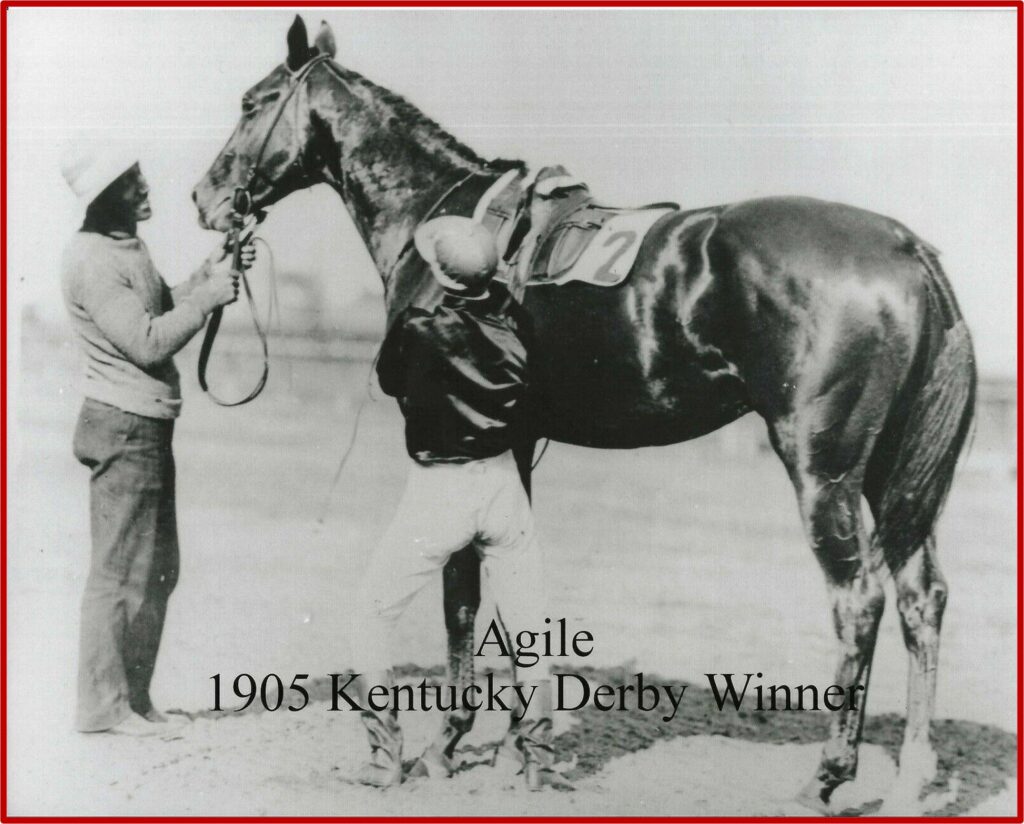

1906
Sir Huon 2:08.80
(1903–1918+)
The bay stallion was named after a character in the German opera Oberon.
Sir Huon won by two lengths over the filly Lady Navarre. His win was notable because it marked the first time since 1902 that a horse had won the Derby without racing as a three-year-old prior to running in the Derby.
In 1918, Sir Huon was given by George Long to the United States Army cavalry remount service as a sire for military horses.
1907
Pink Star 2:12.60
(1904–1914)
The dark bay stallion was named after a character in the German opera Oberon.
Pink Star won the Kentucky Derby by two lengths on a very wet track, with the mud being a fetlock deep in some places.
The “lumbering” and “ugly mount” developed a fever and respiratory infection shortly after the running in another race that permanently impacted his breathing.
By May 1908, Pink Star had been gelded and retired from racing due to poor performance and having a bad temperament. He lived the remainder of his life as a plow horse at the farm of J. Hal Woodford in Louisville, Kentucky. He was noted to be dead by 1914.


1908
Stone Street 2:15.20
(1905–1914)
The bay stallion ran in the Kentucky Derby solely because trainer John Hall believed he could win and refused to scratch the horse at the owners’ request.
He was euthanized in January 1914 after jumping out of his paddock and becoming entangled in wire, which severed one of his hind tendons.
1909
Wintergreen 2:08.20
(1906–1914)
The bay stallion is best known for winning the 1909 Kentucky Derby and for being the first horse bred in Ohio to win the Derby.
Wintergreen was killed April 10, 1914, in a fire that consumed barn #18 at the Latonia Race Track in Covington, Kentucky, just across the Ohio River from Cincinnati. He had been gelded some years previously and was racing for D. Fisk.


1910
Donau 2:06.40
(1907–1913)
The bay stallion is best known for his often temperamental and difficult personality, which led to him being gelded at the end of 1910.
William Gerst (his owner) remarked on Donau’s qualities and personality, “[he] has the speed of a sprinter, the courage of a bulldog, and the gameness of a fighting cock.” Fred Herbert, Donau’s jockey in the Derby, said of the often-temperamental horse, “he likes to be in company and don’t fret a bit when he comes on the track with another horse, while just alone he is a bit nervous.“
He was being retrained as a steeplechaser when he died at the age of six during an epidemic that killed three and sickened 18 other horses at the Nashville farm.
1911
Meridian 2:05
(1908–1935)
The bay stallion is best known for setting a new record by running 11⁄4 miles in 2 minutes, 5 seconds.
Meridian continued to race until he was six years old before being retired from racing to be used as a breeding stallion.
The horse died in 1935 at the age of 27.


1912
Worth 2:09.40
(1909–1912)
The bay stallion is best known for being the favored frontrunner who held off longshot Duval to win by a neck margin. His final time of 2:09.40 is among the slowest in the Derby’s history.
On November 6, 1912, Worth was severely injured during a race run at the Pimlico Race Course in Baltimore, Maryland. Worth’s jockey, McTaggart, rode too closely to another horse, causing a three-horse collision that severely injured two other jockeys and severed two tendons in Worth’s leg. Worth was euthanized shortly after this incident due to blood poisoning from his extensive injuries.
1913
Donerail 2:04.80
(1910–1918+)
The bay stallion is best known for his win standing as the biggest longshot victory in the history of the Kentucky Derby-going off at 91–1.
Because of the overcrowding at the 1913 Kentucky Derby, there were not enough stables, so Donerail was housed at Douglass Park, about three miles away from Churchill Downs, and would have to walk that distance before the start.
It is not known when Donerail died, and much of what became of him after his racing career ended remains a mystery; however, he was retired in 1917 and briefly used as breeding stallion in Lexington, where he commanded a stud fee of $50. In December 1917, Hayes donated Donerail to the Remount Service for use as a sire of cavalry horses.


1914
Old Rosebud 2:03.40
(1911–1922)
The bay stallion is best known for winning the Kentucky Derby by eight lengths in a time of 2:03 2/5, setting a time record that would not be broken for 16 years and a margin record that has been tied but never broken.
Three weeks after the Derby, Old Rosebud sustained a bowed tendon during the May 1914 running of the Withers Stakes at Belmont Park. The race was run clockwise around the track instead of the more customary, in the U.S., counter-clockwise direction. Running the wrong way confused Old Rosebud, who did not change leads coming into the stretch. He was taken out of competition for two seasons as a result of the injury.
Old Rosebud was plagued by ailments throughout his life, culminating in a fatal injury at a claiming race when he was 11 years old and had to be euthanized.
1915
Regret 2:05.40
(1912–1934)
The chestnut filly is best known for being the first of three female horses to ever win the Kentucky Derby.
After the 1917 racing season, Regret was retired for breeding.
The mare died in 1934 at the age of 22.


1916
George Smith 2:04
(1908–1935)
The black stallion is best known for winning the Kentucky Derby.
The 1916 Kentucky Derby was run on a clear day with a field of 9 horses. George Smith was the clear contender of the race from the start. The only competition for the win came from Star Hawk, who lost the race by a neck after a rally in the home stretch.
George Smith was retired from racing at age five and stood at stud. In 1926, George Smith was donated to the Breeding Bureau of The Jockey Club. By the following year, George Smith was in the possession of the U.S. Army Remount Service, where he sired military horses for his remaining years. For the majority of his remount service, he was stationed at the Lookover Stallion Station in Avon, New York.
1917
Omar Khayyam 2:04.60
(1914–1938)
The chestnut stallion is best known as the first foreign-bred horse to win the Kentucky Derby. He was named for the famous Persian mathematician, poet, and astronomer.
He was sent off at 13–1 odds in the Kentucky Derby. Omar Khayyam unleashed a powerful stretch run to come from tenth place to win over the favorite Ticket.
He frequently was handicapped and had to wear up to a 30- pound weight.
He retired as a successful stud until his death.


1918
Exterminator 2:10.80
(1915–1945)
The chestnut gelding was enormous-being gelded to slow his growth to a staggering 17 hands.
Exterminator was not expected to run in the Derby, but had been a companion horse to the designated runner; however, as the race approached, his “trainee” horse developed ringbone.
The morning of the race, track deep in mud, he went off at 30-1.Exterminator raced at the back until the field turned for home, when he launched his bid. Nearing the wire, he passed Escoba and won the Derby by a length.
Racing until the age of 9, a relatively old age for a race horse, Exterminator was called by his many fans “Old Bones” or “The Galloping Hatrack” (amongst the stable lads, he was “Old Shang”). He was retired in 1924 to a life of grass and leisure, with a succession of companion ponies, all named Peanuts, at his side.
1919
Sir Barton 2:09.80
(1916–1937)
The chestnut stallion is best known as the first winner of the Triple Crown.
Sir Barton was known for being a “grouchy” horse, and it was said that the only human he didn’t hate was his groom, Toots Thompson.
Sir Barton led the field of 12 horses from start to finish, winning the race by five lengths. The next day, Sir Barton was shipped to Baltimore to run in the Preakness Stakes, held only three days later on May 14. In the Preakness, he again led all the way, winning wire-to-wire and beating Eternal by four lengths. He then won the Withers Stakes in New York on May 24 and shortly thereafter completed the first Triple Crown in U.S. history by winning the Belmont Stakes on June 11, setting an American record for the mile and three-eighths race, the distance for the Belmont at the time. Sir Barton’s four wins were accomplished in a space of just 32 days.
He retired to stud, but died of colic on October 30, 1937.


1920
Paul Jones 2:09
(1917–1930)
The brown gelding is best known as the sixth gelding to win the Kentucky Derby. He was named after famous Admiral John Paul Jones and a popular brand of whiskey at the time.
The 1920 Kentucky Derby was run on an overcast day on a slow track with a field of seventeen horses. He won the race by a nose after staving off Upset, who showed impressive speed on the home stretch, and On Watch, who was a close third.
Paul Jones raced for a total of five years and, being a gelding with no career at stud, was given to his trainer, William Garth, for use as an exercise pony. Garth spoke favorably of his former charge, complimenting the gelding’s gentle disposition and work ethic. Paul Jones was trained as a steeplechaser and as a hunter and rode him in fox hunts.
Paul Jones was euthanized in April 1930 due to physical infirmities.
1921
Behave Yourself 2:04.20
(1918–1937)
The bay stallion is best known
For going into an all-out drive in the stretch and nipped his stablemate, Black Servant at the wire. How it happened is the stuff of Derby legend: according to some accounts, Black Servant checked stride when someone threw a hat across the racetrack, while others claim that jockey Charles Thompson disobeyed orders to let Black Servant win if possible and caught Black Servant’s jockey napping.
Behave Yourself was not considered a good sire as he had poorly conformed (crooked) legs.
Behave Yourself was donated to the United States Army cavalry remount service in 1930. He spent his remaining years, until his death in 1937, siring cavalry horses for the Army.

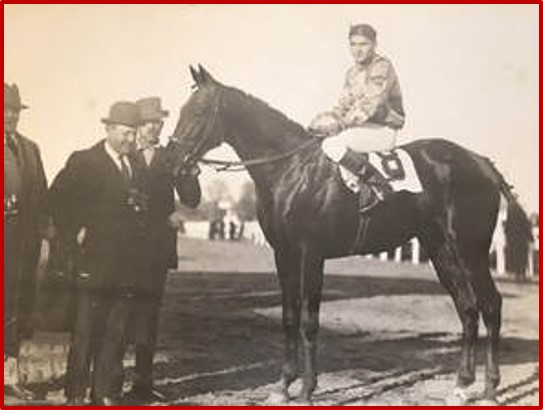
1922
Morvich 2:04.60
(1919–1946)
The brown stallion is best known as the first California bred horse to win the Kentucky Derby.
The young colt was described as an “ugly cripple that no one thought could run until (trainer) Burlew proved them wrong.“
The colt’s knees were the likely cause of his decline. Morvich had also developed osselets in one fetlock.
He retired as an unsuccessful stud.
1923
Zev 2:05.40
(1920–1943)
The brown stallion is best known as being owned by the Rancocas Stable of Harry F. Sinclair, the founder of Sinclair Oil, who was a central figure in the Teapot Dome scandal and served time in prison.
Sinclair named the horse in honor of his friend and personal lawyer, Colonel James William Zeverly.
After successfully campaigning as a four-year-old, Zev retired as racing’s all-time leading money earner, surpassing Man o’ War’s record.
He retired as a stud until his death.
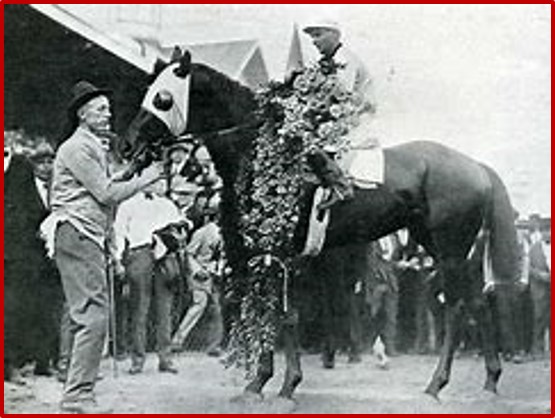
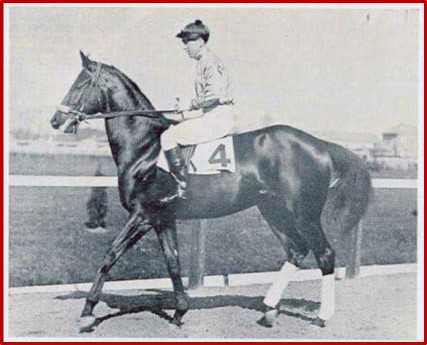
1924
Black Gold 2:05.20
(1921–1928)
The black stallion is named “Black Gold” for his color and for the nickname of oil, which had recently been discovered in Oklahoma, where his owner, a member of the Osage Nation was from. He was nicknamed “The Indian Horse.”
In 1924, the Kentucky Derby was fifty years old and was celebrated as the “Golden Jubilee Derby.” It was the first time a golden cup was presented to the winner and the first time “My Old Kentucky Home” was played before the race. Black Gold won it with a rough trip against strong competition in the last seventy yards. He was bumped and was forced to check but recovered. Racing four and five wide, Black Gold overtook Chilhowee to win.
Black Gold was retired to stud but only sired one foal, a colt, that was killed by a lightning strike.
On January 18, 1928, at the age of seven, he started in the Salome Purse at the New Orleans Fair Grounds. In the stretch, he broke down and finished the race on three legs. He was euthanized at the track.
1925
Flying Ebony 2:07.60
(1922–1943)
The dark bay stallion is best known for winning the 51st Kentucky Derby.
A downpour just before race time turned Churchill Downs into a quagmire that perfectly suited Flying Ebony, who by one and a half lengths.
This Derby was the first ever to be broadcast on the radio.
Flying Ebony retired to stud until his humane death.

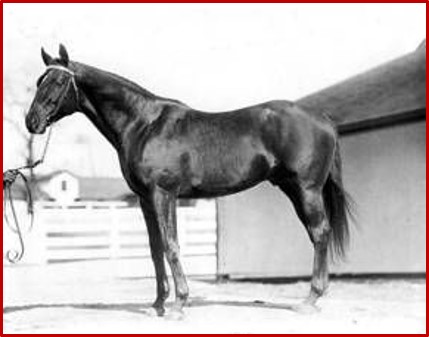
1926
Bubbling Over 2:03.80
(1922–1943)
The chestnut stallion is best known for winning the Kentucky Derby. He ran first in a field of 13, winning by five lengths over second-place finisher.
Bubbling Over had great speed but was bad-legged and bowed a tendon either during the Kentucky Derby or shortly afterward. Contemporary photographs suggest that he was somewhat over at the knees. Because of his poor eyesight (a secret kept by his stable), he needed to take and keep the lead early as he could easily become disoriented if bounced around in traffic.
He retired to successful career at stud until his death.
1927
Whiskery 2:06
(1924–1937)
The bay stallion is best known for winning the Kentucky Derby after defeating Osmand by a nose in the stretch.
He was retired as stud, but proving unsuccessful, he was gelded and used as a saddle horse.
Whiskery’s time of death was not officially reported to The Jockey Club, but it is assumed that he died around 1936 as the result of a catastrophic leg injury, either sustained by colliding with a tree while fulfilling his duty as the night watchman’s horse or as a result of a track injury.

1928
Reigh Count 2:10.40
(1925–1948)
The chestnut stallion is best known for winning the Kentucky Derby with the first Canadian jockey in history to in the most prestigious race.
He was shipped to England to run his “British Campaign” in races there and did so successfully.
TIME magazine reported on December 16, 1929 that his owner had turned down an offer of $1 million for Reigh Count, saying “I think a fellow who would pay $1,000,000 for a horse ought to have his head examined, and the fellow who turned it down must be absolutely unbalanced”. Had the offer been accepted, it would have been by far the largest amount ever paid for a race horse.
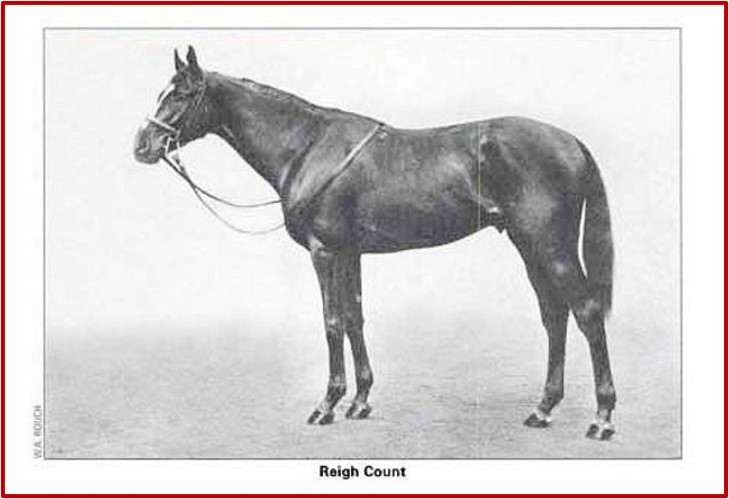
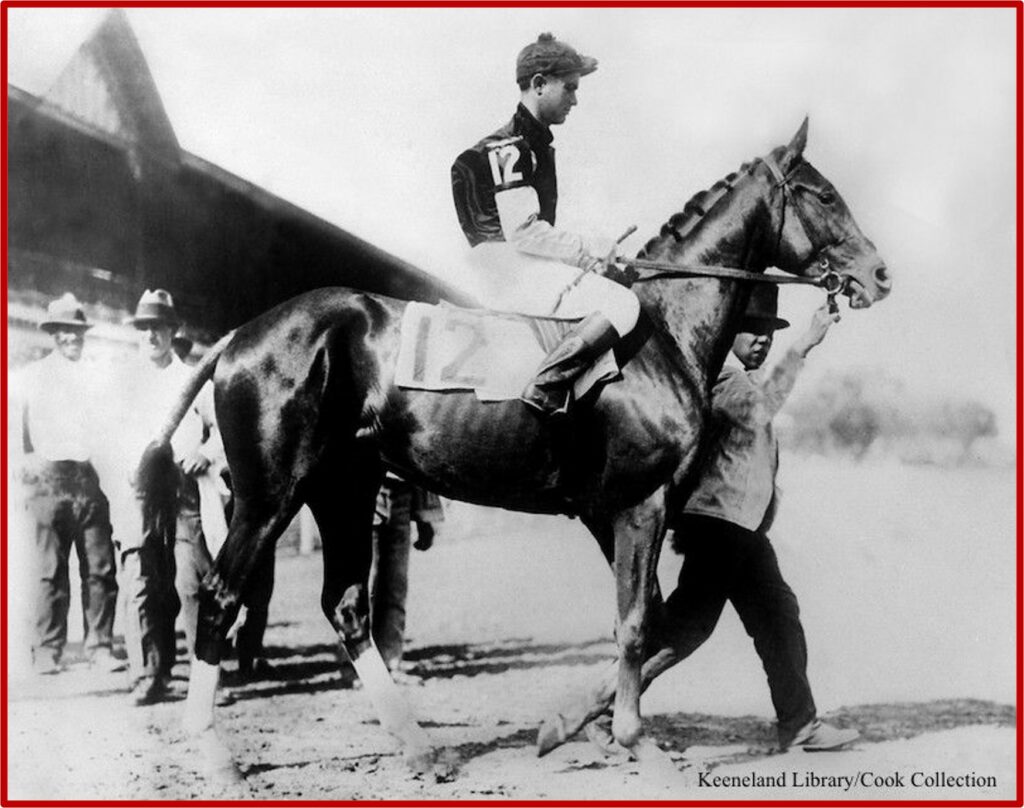
1929
Clyde Van Dusen 2:10.80
(1926–1948)
The chestnut stallion is best known for winning the Kentucky.
Although he was a son of Man o’ War, Clyde Van Dusen had an unimpressive appearance, being described as “a mere pony of a horse with a weedy frame.” Owner/breeder Herbert Gardner, named the horse after his trainer, former jockey Clyde Van Dusen. Van Dusen said, “Clyde is a little horse, and that is why Mr. Gardner named him after me.“
The Derby was run in a downpour, and Clyde Van Dusen was wearing mud caulks on the sloppy track. As a result, he was never seriously threatened and won by 2 lengths, with a time of 2:10 4/5, one of the slowest winning times in Derby history. After the race, Blue Larkspur’s owner, Colonel Edward R. Bradley, called Clyde Van Dusen “the worst horse to win the Derby in twenty years.” Clyde Van Dusen was the seventh gelding to win the Kentucky Derby in the race’s first 55 runnings.
The horse retired and Van Dusen used him as an exercise pony.
1930
Gallant Fox 2:07.60
(1927–1954)
The bay stallion is best known for being the second winner of the Triple Crown.
Early in his career, Gallant Fox was known for being distracted at times, supposedly being late out of the gate in his maiden race due to an airplane flying overhead. Gallant Fox also would become reluctant to run unless there was at least one other horse accompanying him. To help work him out, Fitzsimmons would have other horses placed around the track ahead of Gallant Fox, so he would chase after them.
After winning the Preakness, two weeks later the Kentucky Derby attracted a crowd of 50,000 despite heavy rain at Louisville. He broke slowly but took the lead on the backstretch from the filly Alcibiades before winning by two lengths from Gallant Knight, completing the course in 2:07 3/5 on a muddy track.
Gallant Fox was known as “the red-headed horse” because of the bright red hood that he wore in the races; He retired to stud.
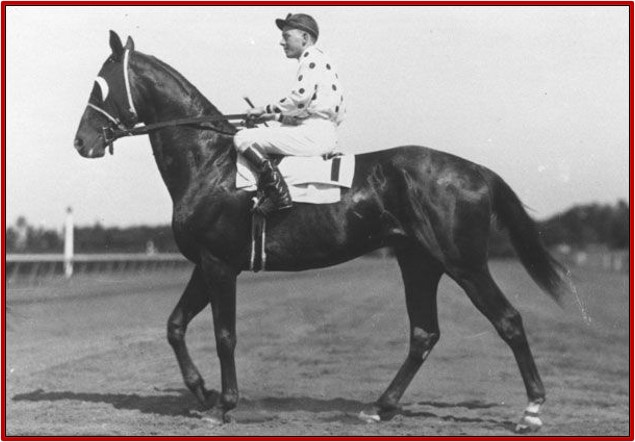

1931
Twenty Grand 2:01.80
(1928–1948)
The bay stallion is best known for winning two of the three legs of the Triple Crown.
Twenty Grand’s fame was reflected in his name and image being used for a brand of cigarettes put out by Axton-Fisher Tobacco Co. In 1936, Axton-Fisher’s right to the Twenty Grand trademark was upheld after it was sued for trademark infringement.
Camp Twenty Grand was an American Army “cigarette camp”, located near Le Havre, France, during World War II and named after the once-popular American cigarette brand (Twenty Grand cigarettes).
He retired to stud, but proved unsuccessful.
1932
Burgoo King 2:05.20
(1929–1946)
The chestnut stallion is best known for forming the second father (Bubbling Over) and-son tandem to win the Derby. The feat had previously been accomplished by 1895 victor Halma and his son Alan-a-Dale, the 1902 winner.
Burgoo King was named for James T. Looney, called the “Burgoo King” for his preparation of traditional Kentucky stew. Looney had prepared burgoo for Colonel Bradley’s charity race meeting for orphans in 1930, and Bradley told him that he would someday name a horse “Burgoo King” in Looney’s honor.
The Derby had a field of twenty starters, but Burgoo King got away cleanly. Shortly into the race stablemate Brother Joe pulled up lame. Although Burgoo King raced two wide with another horse behind the frontrunner, he made a strong move on the backstretch to take the lead and in the homestretch pulled away to win easily by three lengths.
Burgoo King was broken to harness and trained from a sulky, however, he never quite recaptured his earlier form when returned to the track and was retired to stud.
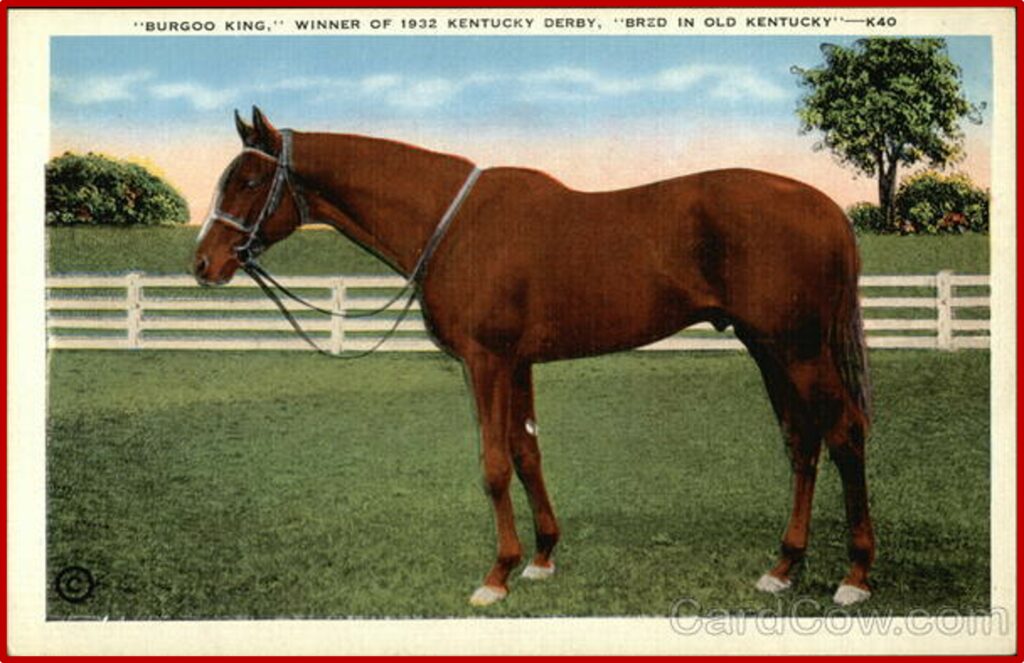
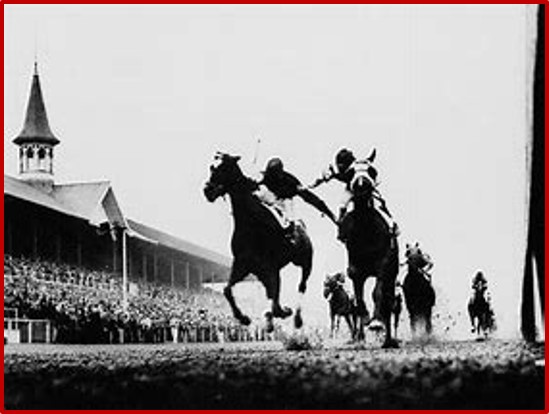
1933
Brokers Tip 2:06.80
(1930–1953)
The bay stallion is best known for the only horse in history whose sole win was in the Kentucky Derby.
His Derby win went down in history as the “Fighting Finish” because Brokers Tip’s jockey (Don Meade) and Herb Fisher (the jockey aboard rival Head Play) literally fought one another atop their mounts down the homestretch. In an era before photo finishes, Brokers Tip was declared the winner by a nose.
He retired to stand stud with success. Broker’s Tip was donated to UC Davis in 1950 for veterinary instructional purposes. His skeleton was preserved for future study at the University of California.
1934
Cavalcade 2:04
(1931–1940)
The brown stallion is best known for winning the Kentucky Derby.
Cavalcade was towards the back of the field before moving into contention behind Discovery and the filly Mata Hari on the final turn. He took the lead in the straight and drew away to win the race by more than three lengths over Discovery.
Cavalcade was retired to stud. In October 1940, at the age of nine, he was being transferred to stand at Shandon Farm near Lexington, Kentucky when he contracted “Shipping fever” and died.
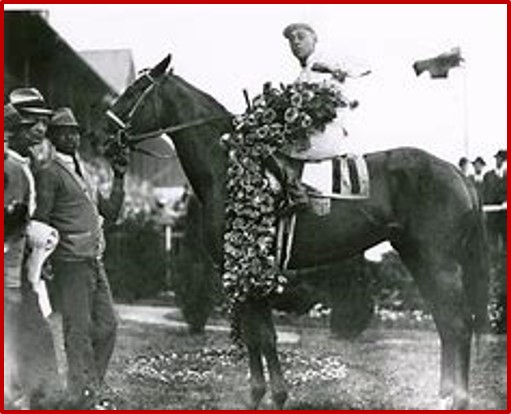
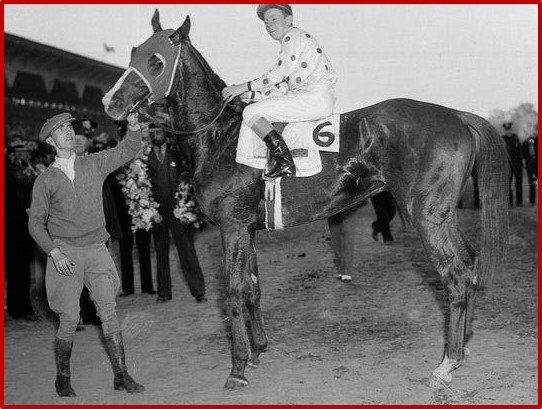
1935
Omaha 2:05
(1932–1959)
The chestnut stallion with a white blaze is best known as the third horse to win the Triple Crown. He stood 16.3 hands high.
Omaha who was described as “a big, leggy, green thing that seems to invariably get into a lot of trouble”. Despite cold weather and heavy rain, the race attracted a crowd of 50,000 to Churchill Downs. His jockey kept Omaha clear of early trouble before moving the colt into the lead in the backstretch. Omaha was never seriously challenged and won by a length and a half without his jockey ever using his whip.
After winning the Crown, he was shipped to England and had a truly astounding and memorable career on the right handed tracks.
In 1937, Omaha was found lame and never raced again.
1936
Bold Venture 2:03.60
(1933–1958)
The chestnut stallion is best known for winning the Kentucky Derby and the Preakness Stakes.
He was ridden by an apprentice jockey in the Derby—a fist ever win by an apprentice.
As soon as the gates opened, Brevity was knocked to his knees, and the horse who would go on to win that year’s American Horse of the Year award, Granville, threw his rider, James Stout. Indian Broom was trapped in a scrum of racing horses. Bold Venture was in no better position. On the way out of the gate, another horse slammed into him, which was like, Hanford said: “…a bowling ball hitting the pins.” This started a chain reaction that caused Granville to throw Stout. But Bold Venture then found running room and by the backstretch had taken the lead. Then Brevity broke free of the pack and came charging after Bold Venture. However, Bold Venture crossed the finish line first.
Bold Venture bowed a tendon and was retired and sold to stud.
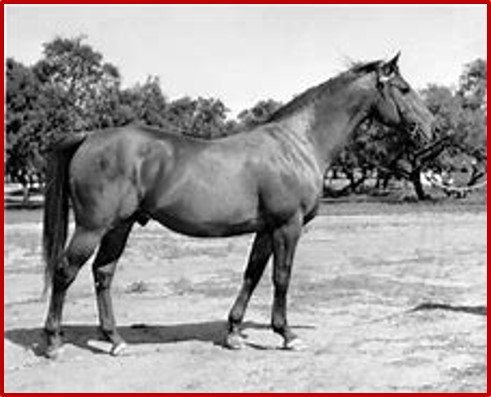
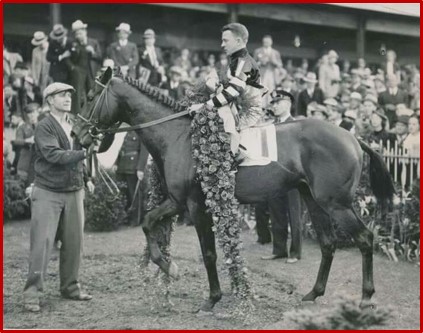
1937
War Admiral 2:03.20
(1934–1959)
The brown stallion is best known for being the fourth winner of the Triple Crown.
Because of his size only 15.2 hands, one of War Admiral’s nicknames was The Mighty Atom.
Most sources say that War Admiral also inherited his sire’s fiery temperament, which manifested chiefly in his reluctance to load in the starting gate. Away from the crowds though, he was more relaxed and given to taking long naps. His groom called him sweet.
War Admiral went off as the favorite, and, despite delaying the start for several minutes, won in wire-to-wire fashion with Pompoon 1+3⁄4 lengths back in second. Neville Dunn, sports editor for the Lexington Herald, wrote, “A little brown horse that takes after his mammy in size but runs like his daddy charged to victory in the 63rd Kentucky Derby… and he won so easily, so effortlessly, that 65,000 fans nudged one another in the ribs and said, ‘I told you so! I told you that War Admiral could run like Man o’ War.’”
War Admiral is on of most prolific leading American sire with numerous champion horses are from his pedigree.
1938
Lawrin 2:04.80
(1935–1955)
The brown stallion is best known for being the only Kansas bred winner of the Kentucky Derby.
During the race, Arcaro took Lawrin to an early 3-length lead keeping to the rail. However, Lawrin started to tire with an eighth of a mile to go and drifted to the middle of the track. Future Hall of Fame jockey Eddie Arcaro, who got the first of his five Derby wins, urged him on and was able keep the lead from a furiously gaining Dauber.
On April 14, 2007, on behalf of the Village Council, the Mayor of Prairie Village, Kansas proclaimed Saturday, May 5, 2007, to be Lawrin’s Legacy Day.
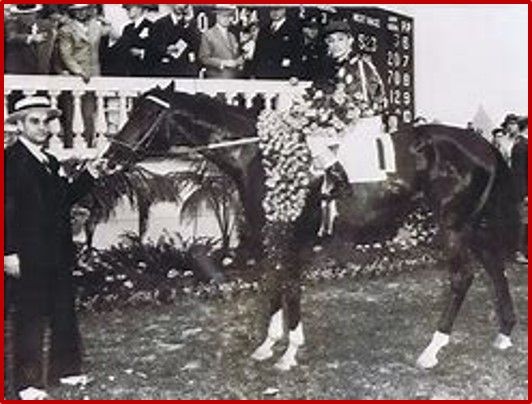
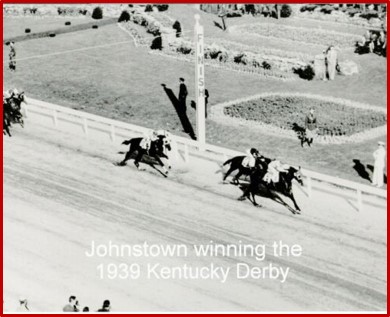
1939
Johnstown 2:03.40
(1936–1950)
The bay stallion is best known for winning the Kentucky Derby.
Johnstown got off to a slow start under jockey James Stout, then he took command by the mile pole and defeated Challedon by eight lengths, tying the (still current, 2015) record for margin of victory.
He retired to mediocre stud success.
1940
Gallahadion 2:05
(1937–1958)
The bay stallion is best known for winning the Kentucky Derby. He was owned by Ethel Mars, of the candy dynasty.
Given almost no chance, Gallahadion was sent off as a 36:1 longshot but under jockey Carroll Bierman scored an upset over Bimelech. For owner Ethel V. Mars, whom the May 9, 1940 Centralia Illinois Evening Sentinel reported had spent more than $500,000 buying horses since 1935 with the eye to winning the Derby.[2] Gallahadion was her eighth horse to run in the Derby in the past six years. Previously, Mrs. Mars’ best results came in 1935 and 1937 when her horses finished third. A severe cold kept her at home and she was not at Churchill Downs to see her horse capture the one race she had wanted to win most of all.
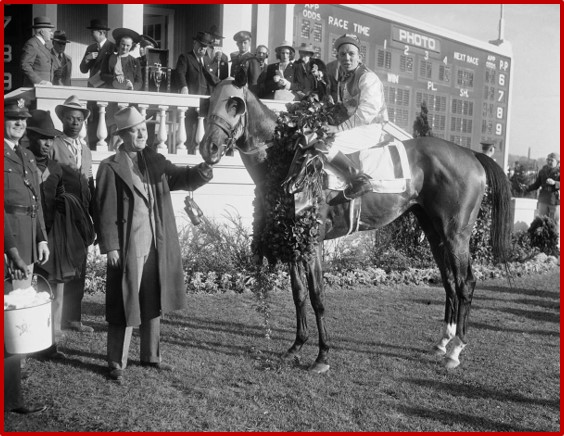
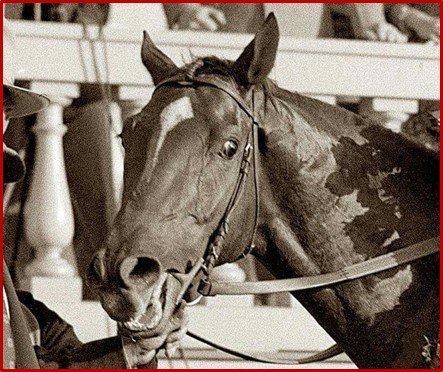
1941
Whirlaway 2:01.40
(1938–1953)
The bay stallion is best known for being the fifth winner of the Triple Crown.
Whirlaway was widely known as “Mr. Longtail” because his tail was especially long and thick and it would blow far out behind him during races, flowing dramatically in the wind.
Jimmy Jones, son of the colt’s trainer, recalled that “Whirlaway was a creature of habit. You had to create habits for him. So we created the habits we wanted him to do.” Whirlaway was regarded as having a “quirky” personality. The champion colt had a habit of “bearing out,” drifting toward the middle of the racetrack, during the latter part of his races and losing as a result. In preparations for the Kentucky Derby, this had been such a problem that trainer Ben A. Jones fitted the colt with a full-cup blinker over his right eye. In Whirlaway’s final workout before the Derby, Jones cut a small hole in the blinker so that the horse had a tiny field of vision. Jones positioned himself ten feet off the inner rail and told jockey Eddie Arcaro to ride the horse through that space. Whirlaway was able to see his trainer, Arcaro was able to keep him on a straight path, and Whirlaway won the Kentucky Derby by tying the current (as of 2018) record margin of 8 lengths.
1942
Shut Out 2:04.40
(1939–1964)
The chestnut stallion is best known for being winning the Kentucky Derby as his fans called him “The Chocolate Soldier.“
Shut Out died in 1964 after a respectable career at stud, siring a number of stakes winners.
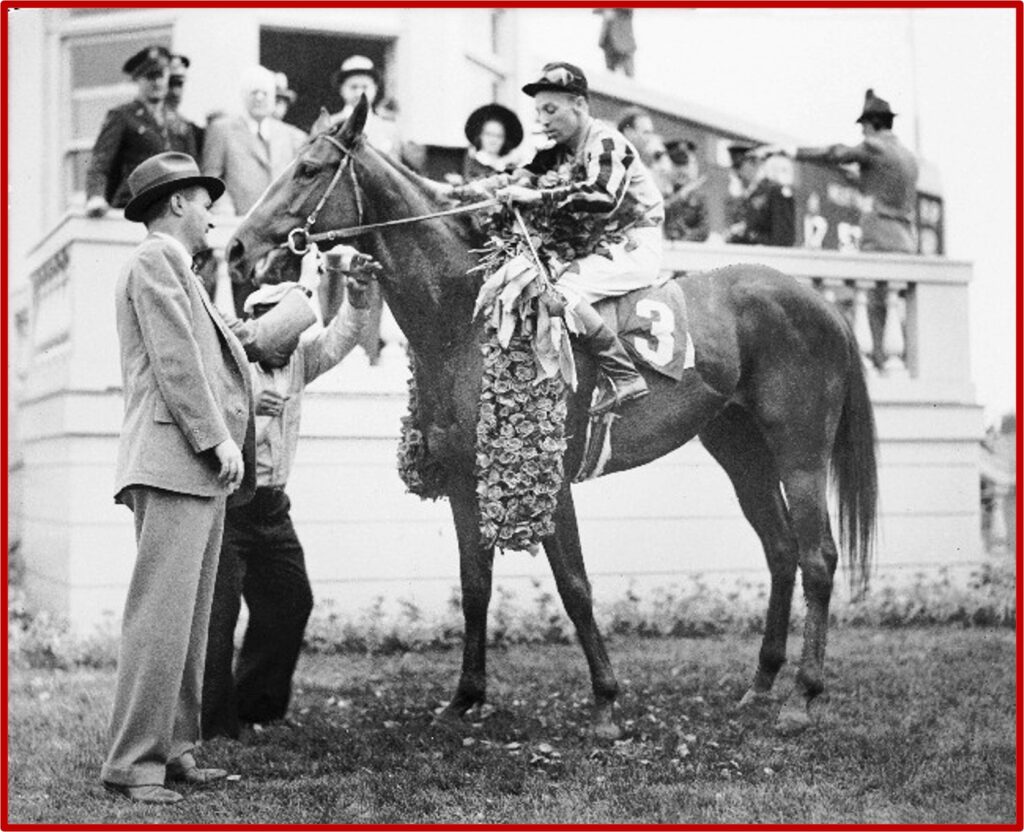
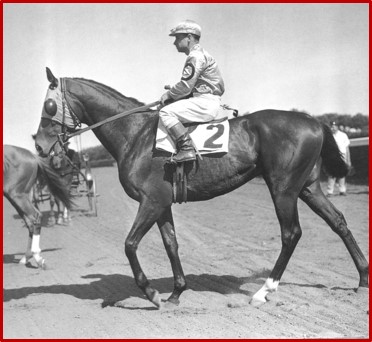
1943
Count Fleet 2:04.40
(1940–1973)
The bay stallion is best known for being the sixth winner of the Triple Crown.
Count Fleet was not a particularly attractive horse, called “narrow, light-waisted, and flat-muscled” by one expert and too leggy and light boned by others. He also had an unruly temperament.
The 1943 Kentucky Derby was almost not run because of wartime restrictions, but Colonel Matt Winn organized it as a “street-car Derby” – restricting travel for out-of-state residents and not allowing cars be driven to the event. Despite this, some 60,000 people attended the race and made Count Fleet the 2-5 favorite – the shortest starting price in Derby history. Count Fleet broke well and challenged Gold Shower, Burnt Shower and Blue Swords for the early lead. After a quarter mile, Count Fleet found himself boxed by the other horses but broke free moving into the first turn. He then moved up to challenge Gold Shower for the lead on the first turn and opened up a two-length lead down the backstretch. On the far turn, Blue Swords mounted a challenge and closed to within a length. Longden then clucked to Count Fleet, who quickly opened a three-length advantage and won handily.
Count Fleet had a series of injuries in the races, often striking his front ankles with his back hooves. He retired early.
1944
Pensive 2:04.20
(1941–1949)
The chestnut stallion is best known for two legs of the Triple Crown, the Kentucky Derby and the Preakness Stakes. In fact, Pensive was the first Kentucky Derby/Preakness Stakes winner to start in the Belmont Stakes but lose the Triple Crown.
Pensive had a muscular body and slightly short legs for his height. He did not have the best of feet. He did his best running from off the pace and was described as being “resolute” when set down for a drive. He was retired in the fall of 1944 due to tendon problems, which may have begun when he rapped an ankle while winning the Preakness Stakes.
Pensive’s Derby may have had the widest viewership of any Kentucky Derby up to that time as it was filmed in color for distribution for showings to American military personnel serving all over the globe during World War II.
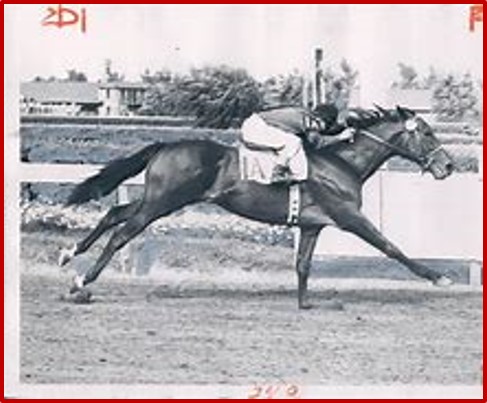
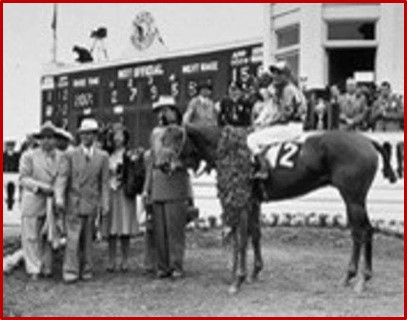
1945
Hoop Jr. 2:07
(1942–1965)
The bay stallion is best known for winning the Kentucky Derby over a muddy track against a field of 15.
He took the lead going past the grandstand the first time and kept increasing it until he won by six lengths against Pot o’ Luck and Darby Dieppe.
He retired to stud in 1946 and lived a successful career until his death.
1946
Assault 2:06.60
(1943–1971)
The ,chestnut stallion is best known for being the seventh winner of the Triple Crown and the only Texas-bred winner.
Described as being “on the delicate side” Assault was plagued with injuries and illnesses from the start. As a youngster, he stepped on what is believed to have been a surveyor’s stake, driving it through his front right hoof. The hoof was permanently deformed, and the colt developed a limp to accommodate the odd shape of his foot; however, the “Club-footed Comet”, as he was later dubbed, showed no signs of abnormality when he was at a full gallop. Throughout his career, Assault also overcame kidney, splint bone, fetlock, knee and bleeding problems.
In the Derby, he raced past rivals to take the first race of the Triple Crown by eight lengths, the largest margin of victory up to that time. At the Preakness Stakes a week later, aggravated by traffic early in the race, his jockey decided to push Assault earlier than usual. He was four lengths in front with a furlong to go. The tiring Assault scored a neck victory over Lord Boswell.
After stumbling at the start of the Belmont Stakes, Assault trailed the field throughout much of the race. In the final 200 yards, he moved past the leaders to win the Belmont by three lengths.
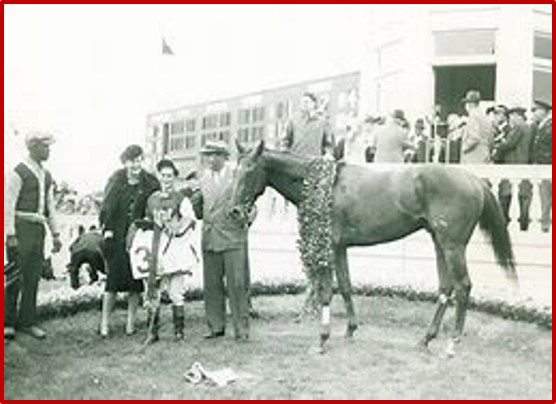
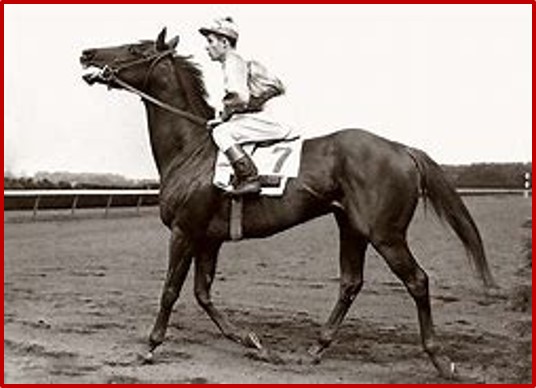
1947
Jet Pilot 2:06.80
(1917–1930)
The bay stallion is best known for winning the Kentucky Derby.
Jet Pilot broke from post position thirteen and immediately took the lead in the 73rd edition of the Derby and never relinquished it.
He bowed a tendon in the Withers Stakes race at Belmont and was retired to stud.
1948
Citation 2:05.40
(1945–1970)
The bay stallion is best known for being the eight winner of the Triple Crown and was the first horse in history to win US$1 million.
In the Kentucky Derby, Citation won by 31⁄2 lengths Citation was then sent to Baltimore where he won the Preakness Stakes by 51⁄2 lengths. There was a 4-week gap between the Preakness and Belmont and Citation’s trainer thought he should run in a race during that time as a “warm-up” for Cy’s Belmont. Citation ran in the Jersey Stakes which he won by an easy 11 lengths. After winning the Belmont stakes, Citation became the eighth Triple Crown winner by winning it by 8 lengths and tying the stakes record of 2:281⁄5 set by the sixth Triple Crown winner, Count Fleet.
He retired to stud and was said to be afraid of the farm owner’s Yorkshire Terrier Timmy Tammy. The dog reportedly nipped at him on several occasions.
Around the time of Citation’s death, a marketing executive at Cessna Aircraft Company, convinced chairman Dwane Wallace to use Citation’s name for the new business jet Cessna was designing. Cessna has continued to use the Citation name and trademark horseshoe logo for an entire series of jet aircraft that comprise the Cessna Citation family.
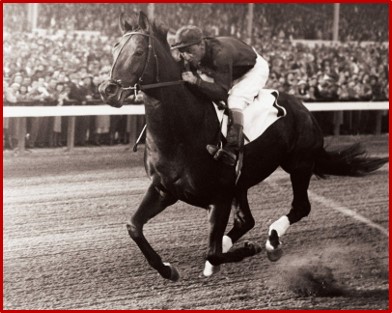

1949
Ponder 2:04.20
(1946–1958)
The dark brown stallion is best known for winning the Kentucky Derby.
In the Derby, for the first mile Ponder was last. He was twelfth after six furlongs and sixth as the field turned for home. Then Ponder began to rally. His gain was described as “relentless,” sweeping him past the rest of the field to win the Derby by three lengths. Ponder ran the last quarter in about :23 4/5.
Ponder retired to stud.
1950
Middleground 2:01.60
(1947–1972)
The chestnut stallion is best known for winning the Kentucky Derby.
Ponder won the Kentucky Derby, only the second horse to win it with an apprentice jockey.
In the 1950 Jerome Handicap, Middleground broke a bone in his foot and was retired. He was successful stud.


1951
Count Turf 2:02.60
(1948–1966)
The bay stallion is best known for winning the Kentucky Derby. He joined the legacy of father/son/grandson winners.
He was named Count for his sire and Turf for the owner’s Turf Restaurant in Times Square.
Count Turf was well placed in the front-middle of the pack and after taking the lead at the top of the homestretch he never looked back and won by four lengths.
He was retired to stud and had minimal success.
1952
Hill Gail 2:01.60
(1949–1968)
The bay stallion is best known for winning the Kentucky Derby in the first live TV broadcast across America.
When Hill Gail began to misbehave in the paddock before the race, Ben Jones reportedly calmed the horse by punching him on the nose. Eddie Arcaro sent the colt to the front after half a mile and Hill Gail produced what was described as a “stupendous burst of speed” to open up a six length advantage by the time the runners rounded the final turn. The outsider Sub Fleet emerged as a challenger in the stretch and Arcaro had to resort to his whip to ensure that Hill Gail reached the wire two lengths in front of Sub Fleet, with the second favorite Blue Man in third. The win gave Arcaro a record fifth Kentucky Derby, whilst trainer Ben Jones was winning the race for a sixth time, also a record. The winning time of 2:01 3/5 was the second fastest time to date. Hill Gail sustained a leg injury in the Derby which prevented him from running in the Preakness and Belmont Stakes.
He was retired to stand as a breeding stallion in Ireland, where he had limited success as a sire.


1953
Dark Star 2:02
(1950–1972)
The brown stallion is best known for winning the Kentucky Derby.
In the Derby, Dark Star started at odds of 25/1, with Native Dancer, unbeaten in eleven races, going off the 3/5 favorite. Apart from the crowd at the track, the race attracted a huge television audience, with three-quarters of American viewers tuning in to the coverage. Dark Star broke quickly from a wide draw and was sent into the lead at the first turn by his twenty-three-year-old jockey Hank Moreno, staying clear of the “bumping and pushing” further back in the field, in which the favorite was badly affected. As the field turned into the straight, Dark Star broke away from his nearest challenger, the Eddie Arcaro-ridden Correspondent, to open a clear lead. Native Dancer produced a powerful late run, but Dark Star held on to win by a head. The winning time was 2:02.0. After the race, Moreno confessed to being surprised by Dark Star’s effort, saying that he had “hoped to run third”.
In the book “Horse Racing’s Top 100 Moments” by the staff of Blood-Horse Publications, Dark Star’s defeat of Native Dancer was ranked number 21.
He retired to stand at stud.
1954
Determine 2:03
(1951–1972)
The gray stallion is best known for winning the Kentucky Derby-the first gray horse to do so.
Determine, a soft gray in color, grew to a little over fifteen hands and never weighed more than 900 pounds. At the time of his Derby win he was described in the press as being a “pint-sized colt” and “a little package of dynamite”.
Right out of the gate, York (his jockey) was almost unseated. Timely Tip, who had won the Arkansas Derby, cut over badly from the outside. In what Churchill Downs describes as one of the roughest Derby’s ever run, Determine stayed on his feet, and York stayed in the saddle. Hasty Road was well in the lead, but Determine caught him 1/16 of a mile from the finish and won by a length and a half, becoming the first gray to win the Derby.
Determine retired to successful stud career.


1955
Swaps 2:01.80
(1952–1972)
The chestnut stallion is best known for winning the Kentucky Derby.
He was known as the “California Comet,” and occasionally with affection, due to his wins despite numerous injuries and treatments, the “California Cripple.“
Swaps did not compete in the Preakness or Belmont because he had a split hoof wall in his right forefoot, incurred in January, and it had inflamed again. The hoof troubled him throughout his racing career.
He retired to stud.
1956
Needles 2:03.40
(1953–1984)
The bay stallion is best known for winning the Kentucky Derby and the Belmont Stakes. He became the first Florida-bred horse to win the Kentucky Derby.
Needles was a sickly foal who was given his name because of the numerous veterinary injections he was given to overcome broken ribs and pneumonia.
Needles won the 1956 Kentucky Derby by coming from 16th place in a field of 17 to make up 24 lengths and win “going away”.
At age four, Needles started three times, finishing 1, 2, and 3. His 1957 racing season ended early following an injury.
He retired to stud.


1957
Iron Liege 2:02.20
(1954–1972)
The bay stallion is best known for winning the Kentucky Derby.
In the Derby, Iron Liege took the lead over pacesetter Federal Hill but encountered a fast-charging Gallant Man in deep stretch. As the two passed the +1⁄16 mile pole, Gallant Man’s rider, future Hall of Fame jockey Bill Shoemaker, stood up in his irons long enough for Gallant Man to briefly lose his stride. Iron Liege held off Gallant Man and won by a nose in a driving finish, with Round Table third and Bold Ruler fourth.
After first blaming his actions on a bad step by Gallant Man, Shoemaker admitted that he misjudged the +1⁄16 mile pole as the finish line, and he was suspended 15 days by the Churchill Downs stewards for “gross carelessness”. His gaffe has been noted in books, in articles, and on online sites as one of the biggest blunders in racing history.
He retired to stud in Japan.
1958
Tim Tam 2:05
(1955–1982)
The dark bay stallion is best known for winning the Kentucky Derby and the Preakness Stakes.
After winning the Preakness Stakes, Tim Tam was considered to have a strong chance to capture the American Triple Crown. However, in the Belmont Stakes, coming down the home stretch toward the lead that seemed to assure victory, Tim Tam fractured a sesamoid bone and hobbled the last yards across the finish line in second place.
His injury ended his career but he went on to be a successful sire.
The Tim Tam chocolate biscuit manufactured by Arnott’s in Australia was named after the horse.


1959
Tomy Lee 2:02.20
(1956–1971)
The British born dark bay stallion is best known for being only the second non-American bred horse to ever win the Kentucky Derby.
At two, Tomy Lee stood 16 hands, weighed a bit over a thousand pounds, and was sound. The press called the bay with four white stockings a greyhound, slim and perfectly proportioned.
Early on in the race, Tomy Lee was involved in a speed duel with Troilus, and won it, so when Sword Dancer made his move under Bill Boland, Shoemaker thought Tomy Lee was spent and Sword Dancer might take the Derby. Seeing Boland come up, he called, “Good luck, I hope you win it.” Sword Dancer took over the lead by half a length, but Tomy Lee came on again in mid stretch, behind by only a head. The horses bumped several times. At the wire, Tomy Lee won by a nose. Boland claimed a foul, but the judges disallowed it after deliberating for 17 minutes.
He continued racing until 1963 and was retired to stud.
1960
Venetian Way 2:02.40
(1957–1964)
The chestnut stallion is best known for winning the Kentucky Derby. He was named after a street in Miami Beach.
In the 1960 Kentucky Derby- the “drugstore Derby”- Venetian Way beat Bally Ache. Venetian Way was a sore horse who responded admirably to Butazolidin, legal in Kentucky at the time. When Venetian Way ran in the Preakness two weeks later without the help of Butazolidin (pain-killing drugs are not legal in Maryland), he did not finish in the money while the sound-legged Bally Ache won. The performance of Venetian Way with and without Butazolidin and other similar cases convinced the Kentucky State Racing Commission that drugs were unfair to the horse and to the public.
Ridden in the Kentucky Derby by future U.S. Racing Hall of Fame jockey Bill Hartack, Venetian Way remained within striking distance, then passed Bally Ache as they came around the final turn heading into the homestretch and won going away by 3½ lengths. In the ensuing 1960 Preakness Stakes, Venetian Way finished fifth to winner Bally Ache.


1961
Carry Back 2:04
(1958–1983)
The dark brown stallion is best known for winning the Kentucky Derby and the Preakness Stakes.
As a three-year-old, Carry Back was described by an Associated Press reporter as a “little, scrawny” horse who weighed no more than 970 pounds. The horse was sometimes referred to by the nicknames “C. B.” and “The People’s Choice”.
In the Derby, Carry Back started predictably slowly and was towards the rear, sixteen lengths behind the leaders in the early stages as Globemaster led from Four-and-Twenty and Crozier. Sellers began to move forward in the backstretch and brought the colt around the outside of the field before making his challenge in the stretch. Carry Back produced what reporters described as a “devastating stretch run” to catch Crozier in the closing stages and win by three quarters of a length. The slow winning time of 2:04.00 was accounted for by the “sticky” track conditions.
He had several retirements and comebacks and lived to be one of the oldest of the Derby winners.
1962
Decidedly 2:00.40
(1958–1983)
The gray stallion is best known for winning the Kentucky Derby.
A light-bodied gray horse of superb balance and quality, Decidedly resembled his sire Determine but was longer-legged. He was rather delicate of constitution and did not stand hard races close together. His action was low, sweeping and fluent. He had a difficult disposition, particularly as a youngster.
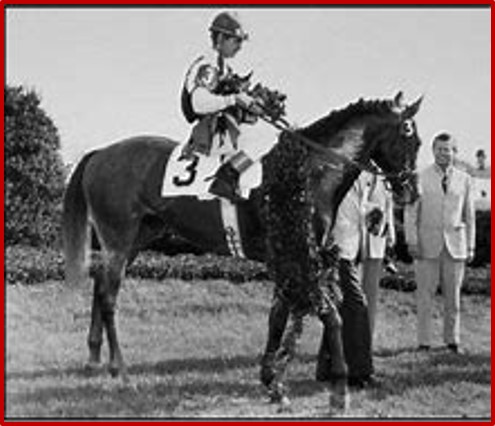

1963
Chateaugay 2:01.80
(1960–1985)
The chestnut stallion is best known for winning the Kentucky Derby and the Belmont Stakes.
After running in sixth place through the first three-quarters of a mile, coming out of the backstretch Chateaugay moved to the far outside and raced into fourth place. As they turned for home, jockey Braulio Baeza spotted an opening between the second- and third-place horses. He raced through it to pull alongside Never Bend and then moved ahead to win the race by 1+1⁄4 lengths.
A well-balanced golden chestnut horse who appeared smaller than he actually was, Chateaugay stood 16.1 hands. He had a shorter back and more close-coupled build than his sire Swaps. His legs were correct except for a slight tendency toward tied-in tendons, but he had a rather mulish head. He had an excellent shoulder, short cannons, good feet and good length from hip to hock, affording him considerable leverage in his stride. He was not always inclined to give his best on the racetrack and was not an easy ride. He did his best running from off the pace. His temperament issues may have been related to his numerous physical problems: he was hampered by respiratory issues that delayed his entry to racing until fall of his 2-year-old season, and he was also troubled by a splint between his juvenile and 3-year-old seasons and at 4 and 5 by an ankle injury suffered late in his 3-year-old season.
He was sold to Japanese interests and retired to stud in Japan.
1964
Lucky Debonair 2:01.20
(1962–1987)
The bay stallion is best known for winning the Kentucky Derby.
A deep-bodied bay horse standing 15.3 hands, Lucky Debonair had a good shoulder, good bone and short cannons but had a bit too much angulation in his pasterns. He was too backward for much juvenile racing and ended up making only one unplaced start at 2 in which he bucked his shins. He bucked shins again and also ran down on his right heel while running in the 1965 Preakness Stakes and was sidelined by splints for the remainder of the year. He was retired due to another injury following his 1966 Santa Anita Handicap win. He had a kind and willing disposition and could be placed anywhere in a race as his jockey desired. His one fault as a racer was a tendency to pull himself up after making the lead.
Lucky Debonair’s Kentucky Derby day was enlivened by a fire caused by a stray cigarette in the clubhouse next to the first turn, about two hours before post time. Flames shot 10 feet into the air before being extinguished, and post time was put back by 30 minutes to allow the soaked section of the track to be gotten back into racing order.
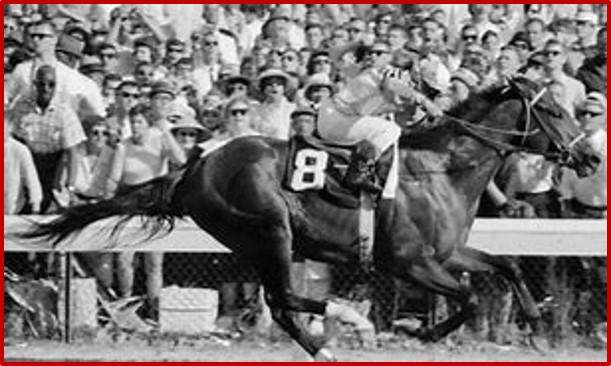

1965
Chateaugay 2:01.80
(1960–1985)
The chestnut stallion is best known for winning the Kentucky Derby and the Belmont Stakes.
After running in sixth place through the first three-quarters of a mile, coming out of the backstretch Chateaugay moved to the far outside and raced into fourth place. As they turned for home, jockey Braulio Baeza spotted an opening between the second- and third-place horses. He raced through it to pull alongside Never Bend and then moved ahead to win the race by 1+1⁄4 lengths.
A well-balanced golden chestnut horse who appeared smaller than he actually was, Chateaugay stood 16.1 hands. He had a shorter back and more close-coupled build than his sire Swaps. His legs were correct except for a slight tendency toward tied-in tendons, but he had a rather mulish head. He had an excellent shoulder, short cannons, good feet and good length from hip to hock, affording him considerable leverage in his stride. He was not always inclined to give his best on the racetrack and was not an easy ride. He did his best running from off the pace. His temperament issues may have been related to his numerous physical problems: he was hampered by respiratory issues that delayed his entry to racing until fall of his 2-year-old season, and he was also troubled by a splint between his juvenile and 3-year-old seasons and at 4 and 5 by an ankle injury suffered late in his 3-year-old season.
He was sold to Japanese interests and retired to stud in Japan.
1966
Kauai King 2:02
(1963–1989)
The dark bay stallion is best known for winning the Kentucky Derby and Preakness stakes and was the only official Maryland-bred winner of the Derby.
A medium-sized, well-balanced dark bay horse of robust build, Kauai King stood 16 hands. He possessed the powerful hindquarters of his sire, Native Dancer, but also had his sire’s rather suspicious-looking ankles. His temperament as a racehorse was sensible. While he preferred to run on or near the lead, he rated well and had a good turn of foot when needed. He was completely genuine in a drive. He had a rather rounded running gait resembling his sire’s. Kauai King stumbled at the break of the 1966 Arlington Classic (a race that his trainer had not wanted to run him in) and bowed a tendon, ending his racing career.
Owner Mike Ford explained that he gave Kauai King his name because Kaua’i was the one island not conquered by Kamehameha I when he united the inhabited islands of Hawai’i under a single monarchy. (After two failed invasion attempts by Kamehameha, Kaua’i’s ruler, Kaumuali’i, elected to submit voluntarily to Kamehameha’s authority rather than face a third possible invasion; he retained the rulership of Kaua’i as Kamehameha’s vassal.) Ford’s hope was that his colt would prove as unconquerable as Kaua’i.
Kauai King’s barn name was “Old George.”
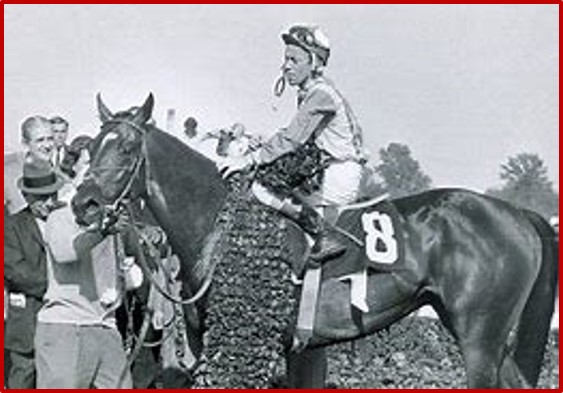
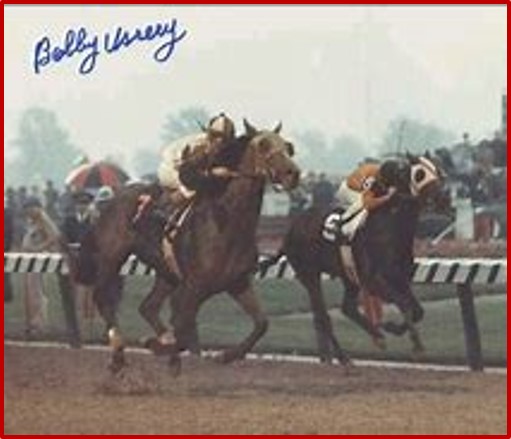
1967
Proud Clarion 2:00.60
(1964–1981)
The bay stallion is best known for winning the Kentucky Derby.
Proud Clarion was a well-built, rather leggy individual of classic type. His fetlock joints were weak and he was not the soundest of runners. He was nervous and a poor doer as a juvenile but became calmer and a better eater as he matured.
Proud Clarion’s Derby took place in a tense atmosphere occasioned by earlier civil rights protests in the Louisville area. Because of the potential for riots, several Derby Week activities were canceled including the Pegasus Parade and a country music concert, and the Kentucky National Guard was called out to bolster the Louisville Police Department and a contingent of Kentucky State Police at the Derby.
Another disruption was caused by the University of Louisville, which refused to send its band to play “My Old Kentucky Home” for the post parade after receiving threats from an anonymous caller. Two other schools also refused to send their bands for similar reasons, and members of the Louisville Musician Union filled in at the last minute.
At the race, leaving the starting gate from post position seven, Proud Clarion raced ninth near the back in a pack of horses until close to the ¾ mile pole when jockey Bobby Ussery made a move. By the mile pole he was sitting fifth then in the homestretch accelerated through an opening between Damascus and Diplomat Way. He caught front-runner Barbs Delight then raced on to win by a length in the third-fastest time in the Derby’s history to that point.
1968
Forward Pass 2:02.20
(1965–1980)
The bay stallion is best known for being the first horse in the history of the Kentucky Derby to have been declared the winner as the result of a disqualification. He also won the Preakness Stakes.
Forward Pass finished second, but winner Dancer’s Image was disqualified to last place after traces of phenylbutazone were discovered in the mandatory post-race urinalysis. As a result, Forward Pass was declared the winner. The controversy filled the sporting news of media outlets in North America and was a cover story for Sports Illustrated, which referred to it as “the year’s major sports story.“
He retired to stud and then was sold to a breeding farm in Japan.
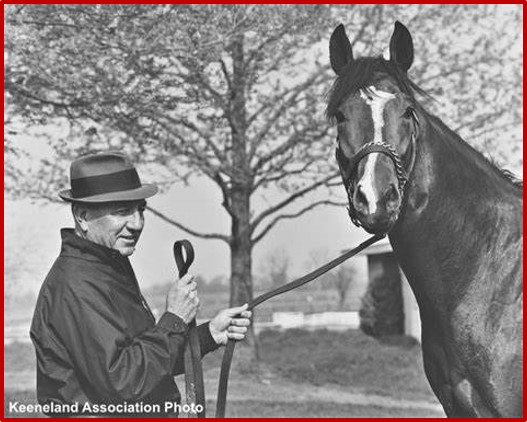

1969
Majestic Prince 2:01.80
(1966–1981)
The chestnut stallion is best known for winning the Kentucky Derby.
Majestic Prince drew the last post position. Arts and Letters, racing along the rail, took the lead by the time they reached the mile pole and were about to head for the stretch run. Majestic Prince ran the entire race on the outside, but pulled up alongside Arts and Letters into second place as they came down the homestretch, then moved ahead to win by a neck. The victory made Majestic Prince the first unbeaten Kentucky Derby champion in 47 years.
The horse had a developing tendon injury and did not run in the Preakness despite grueling pressure and disbelief. Majestic Prince returned to run in the Belmont, but the jockey said that the horse was hurting and never should have run.
1970
Dust Commander 2:03.40
(1967–1991)
The chestnut stallion is best known for being the first Illinois born horse to win the Kentucky Derby.
Ridden by long-time Kentucky resident Mike Manganello, Dust Commander was bumped hard at the start from Post 2, recovering to advance along the inside until the final turn, when he split horses to kick into gear for a dominating stretch run
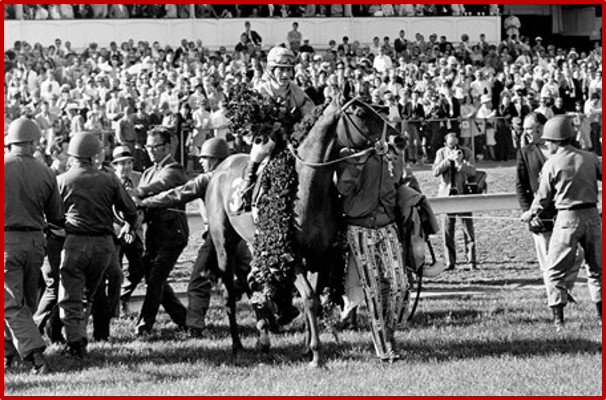

1971
Canonero II 2:03.20
(1968–1981)
The bay stallion is best known for winning the Kentucky Derby and the Preakness Stakes and was owned by Venezuelan breeders.
In the Derby’s 20-horse field, Canonero II shocked everyone by coming from 18th place to storm past the competition, easily winning the race by 33⁄4 lengths. Arguably the most astonishing upset in the race’s history was deemed a fluke by many of horse racing’s experts, who predicted Canonero II would never win another race. However, in the Preakness Stakes, the second of the Triple Crown races, Canonero II won again.
The third leg of the Triple Crown, the Belmont Stakes, was run before the largest crowd in its history. The stands were filled with members of the city’s large Latino community, there to cheer on their new hero. However, due to a foot infection that had bothered the horse for several days, Canonero II, after taking the race lead, struggled across the finish line in fourth place. Despite this loss, he was named the winner of the 1971 Eclipse Award for Outstanding Three-Year-Old Male Horse.
1972
Riva Ridge 2:01.80
(1969–1985)
The bay stallion is best known for winning the Kentucky Derby and the Belmont Stakes.
Riva Ridge was a light bay stallion who stood 16 hands high. Riva Ridge’s name came from Chenery’s daughter Penny and her husband, John Tweedy, honoring their favorite ski run at Vail, Colorado. Tweedy had trained with the U.S. Army’s Tenth Mountain Division in Colorado in 1943, but later served in Burma with the OSS. Upon his return from the war, he and fellow veterans from the Tenth Mountain division founded Vail Ski Resort in Colorado in 1962. They named the longest run “Riva Ridge” after a costly but important strategic victory by the U.S. Army’s 10th Mountain Division on February 18 in the North Apennine mountains of Italy.
Riva Ridge was described by Penny Chenery as a very timid and unassuming horse who “ran to get away from [other horses].” He was nicknamed “Old Pea Head” while racing.
The morning of the Kentucky Derby, larger holes were cut in Riva Ridge’s blinkers because it would help the horse should he need to go to the front early in the race. In the Derby, the other jockeys held their horses back early on, as Turcotte expected, and Riva Ridge took the lead early, holding it throughout the race to win by 3+1⁄4 lengths.
Riva Ridge’s winnings as a two saved the Meadow Stable, paving the way for stablemate, Secretariat.


1973
Secretariat 1:59.40
(1967–1991)
The chestnut stallion is best known for being the ninth winner of the Triple Crown. His nickname was “Big Red”.
Secretariat grew into a massive, powerful horse said to resemble his sire’s maternal grandsire, Discovery. He stood 16.2 hands when fully grown. He was noted for being exceptionally well-balanced, described as having “nearly perfect” conformation and stride biomechanics. His chest was so large that he required a custom-made girth, and he was noted for his large, powerful, well-muscled hindquarters. An Australian trainer said of him, “He is incredible, an absolutely perfect horse. I never saw anything like him.“
Secretariat obliterated the records at the three racetracks and became a celebrity—which he remains today!
Secretariat died of laminitis. His owner remained a prominent figure in racing and a powerful advocate for thoroughbred aftercare and veterinary research until her death.
1974
Cannonade 2:04
(1971–1993)
The bay stallion is best known for winning the Kentucky Derby.
In front of a record Churchill Downs crowd of 163,628, Cannonade went to the post along with twenty-two other horses in the largest Derby field ever. Cannonade worked his way through the unwieldy field and was in front by mile pole. He never relinquished the lead, winning by 2¼ lengths in a time of 2:04 on a track rated as fast.
Cannonade retired after his 1974 racing season to stand at stud at Gainesway Farm.
Cannonade lived until the age of twenty-two, when he was euthanized on August 3, 1993, reportedly due to infirmities of natural causes.


1975
Foolish Pleasure 2:02
(1972–1994)
The bay stallion is best known for winning the Kentucky Derby.
In the Derby, he raced well off the pace on the inside before making a forward move approaching the final turn. He was switched to the outside in the straight and produced a strong late burst to win from Avatar.
Foolish Pleasure was placed at Greentree Stud after being syndicated for US$4.5 million. He later spent time at Mint Lane Farm and Spendthrift Farm in Kentucky before being moved out to Kerr Stock Farm in California. He was purchased by Ron Vanderhoef in September 1993 and moved to Horseshoe Ranch in Dayton, Wyoming, where he remained until he died from a gastric rupture on November 17, 1994.
1976
Bold Forbes 2:01.60
(1973–2000)
The dark bay stallion is best known for winning the Kentucky Derby and the Belmont Stakes.
Ridden by Angel Cordero, he led the Derby from the start, setting a “blistering pace”, and won by half a length from the 2/5 favorite Honest Pleasure.
In the Preakness Stakes Bold Forbes again took an early lead and set an exceptionally fast pace, but after a prolonged battle with Honest Pleasure, both horses tired in the final stages and were beaten by Elocutionist, with Bold Forbes finishing third.
In the Belmont Stakes, Bold Forbes again led from the start and won by a neck from McKenzie Bridge with Great Contractor a further neck away in third.
He was retired to stand stud. Until his death, he was the oldest living Kentucky Derby winner. He died on August 9, 2000, at the age of 27 after being humanely euthanized due to renal failure and complications from gastroenteritis.


1977
Seattle Slew 2:02.20
(1974–2002)
The dark bay stallion with a white patch of hair by his left rear hoof, is best known for being the 10th winner of the Triple Crown.
As a foal, Seattle Slew’s looks were compared to a mule. He was so awkward he was nicknamed Baby Huey. He was named him for the city of Seattle and the sloughs loggers used to transport heavy logs. Slough-a slow-moving channel of the Pacific Northwest —was changed to Slew.
At the Derby, Seattle Slew washed out in the paddock and again during the post parade. The jockey moved him away from the crowd to relax. He had drawn post position three, and had to wait in the starting gate for the rest of the field to load. Slew reacted slowly at the break then swerved nearly sideways and found himself trapped near the back of the field. He charged through the field, bumping several other horses who were in his way. After two furlongs, he had worked his way into second place. The two colts dueled before Seattle Slew relaxed down the backstretch, under a tight restraint, allowing For the Moment to open up a lead of a length. At the top of the stretch, the jockey went to the whip and Seattle Slew pulled away by 4 lengths, then shut down in the final eighth of a mile to win by 1+3⁄4 lengths. Seattle Slew was visibly upset after the race. “It was the only time I was scared of him,” said his groom. “He was so high-strung that night, he was evil, just evil. I couldn’t believe how wound tight he was. It was like he hadn’t even been in a race. I had to take him from the hotwalker and he ran over me a couple of times. I’d never seen him like that before.”
Seattle Slew retired to stud, leaving a legacy of winners. He underwent spinal fusion surgery for a neurological condition in 2000, followed by a second surgery in 2002. Upon recovery from the second surgery,
On May 7, 2002, 25 years to the day after he won the Kentucky Derby, Seattle Slew died in his sleep at age 28.
1978
Affirmed 2:01.20
(1975–2001)
The chestnut stallion is best known for is best known for being the 11th winner of the Triple Crown.
At the start of the Kentucky Derby, Sensitive Prince took the early lead as Affirmed ran in third, while Alydar stayed far back. Affirmed made a strong move for the lead on the far turn, put away a challenge by Believe It, and held off Alydar’s fast-closing charge to win by 1+1⁄2 lengths.
In the Preakness Stakes, Affirmed set the pace. Alydar made his big move on the far turn, Affirmed held a short lead entering the stretch and held it to defeat Alydar by a neck.
In the Belmont, Affirmed led and set a very slow pace, going the first quarter mile in 25 seconds and the half in 50 seconds. Alydar’s jockey put Alydar close to the pace and moved alongside Affirmed with more than seven furlongs to go. For more than six) furlongs, the colts raced neck and neck, pulling away from the rest of the field. Alydar got his nose in front at mid-stretch, but just as Affirmed appeared to tire, his jockey went to a left-handed whip, something he hadn’t done before in his eight rides on Affirmed. Affirmed won by a nose.
He had a successful stud career. In 2001, Affirmed was euthanized after falling seriously ill with laminitis, a circulatory hoof disease.


1979
Spectacular Bid 2:02.40
(1975–2001)
The very dark grey stallion, that became dappled as he aged, is best known for winning the Kentucky Derby and the Preakness Stakes. He lived on the Eastern Shore!
Spectacular Bid seemed nervous before the start of the Derby, but his trainer was so confident of victory that as the horse paraded in front of the fans, he called, “Go bet! Go bet!” Spectacular Bid was restrained by the jockey in the early stages before moving up on the outside to take the lead on the far turn. He drew clear in the straight and won by 2+3⁄4 lengths over General Assembly, with Golden Act in third.
In the Preakness, he was bumped early, he ran wide and by the final stretch was in command. He handily won the race, outpacing his competitors to win by 5+1⁄2 lengths. His time of 1:54.2 was faster than that of Seattle Slew or Affirmed,
On the morning of the Belmont Stakes, a freak accident was discovered: Spectacular Bid had stepped on a safety pin. The pin had become embedded in his hoof, later leading to an infection that required the hoof to be drilled to cure the problem. However, after the discovery of the injury, Spectacular Bid did not seem lame and was entered into the race and lost.
He was retired to stud. Spectacular Bid died from a heart attack on June 9, 2003.
1980
Genuine Risk 2:02
(1977–2008)
The chestnut filly is best known for being the 2nd mare to win the Kentucky Derby.
As the field rounded the final turn at Churchill Downs, as the crash of more than 130,000 people cheering greeted their entrance into the stretch, the jockey urged Genuine Risk to pass Rockhill Native and Plugged Nickle and take the lead. She zipped past them, the jockey switching to his left hand to tap her with his whip. As Genuine Risk worked to put space between her and the field, Rumbo and Jaklin Klugman threatened with late charges at the filly, but to no avail: Genuine Risk had won the Kentucky Derby by one length, only the second filly in history to beat her male peers and wear the blanket of roses.
She is the only filly in history to race in three events of the Triple Crown. Her finish in the Preakness was disputed as the winning jockey was said to interfere with her, even hitting her in the face with his crop. She placed 2nd in the Preakness and Belmont Stakes.
She retired as a broodmare and at the age of 31, she died in her paddock at the Firestone family’s Virginia-based Newstead Farm on Monday, August 18, 2008.

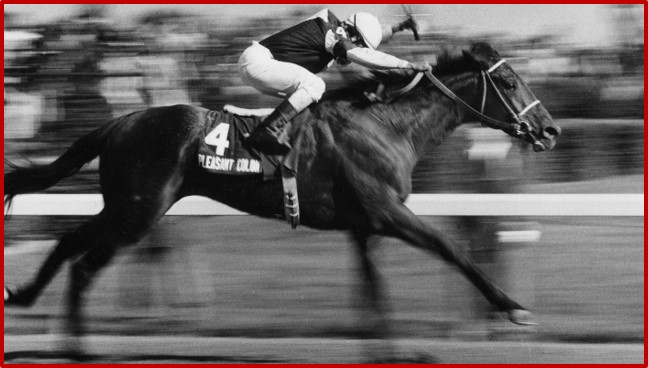
1981
Pleasant Colony 2:02
(1978–2002)
The dark bay stallion is best known for winning the Kentucky Derby and the Preakness Stakes.
Pleasant Colony was a big, gangly horse standing just under seventeen hands.
In the 1981 Kentucky Derby under regular jockey Jorge Velasquez, Pleasant Colony held off a powerful stretch drive by Woodchopper to win by three-quarters of a length. The expected rivalry with Woodchopper never materialized in the Preakness Stakes. Pleasant Colony came from behind to win by a length over Arkansas Derby winner Bold Ego with Woodchopper far back in eleventh place. In the third and final leg of the Triple Crown series, the Belmont Stakes, Pleasant Colony finished third to winner Summing.
From age 4-20, he stood stud producing several significant stakes winners.
1982
Gato Del Sol 2:02.40
(1979–2007)
The grey stallion is best known for winning the Kentucky Derby.
Given little chance by Churchill Downs bettors against the favored Wood Memorial Stakes winner Air Forbes Won, Gato Del Sol was sent off at odds of 21-1, the third longest in the race. He trailed the nineteen-horse field in the 1¼ mile race early but under jockey Eddie Delahoussaye began making a move after half a mile. By the mile pole, he had moved up to fifth place. He continued to gain ground as the field moved down the homestretch, with six horses spread across the track racing head-to-head. By the final furlong marker, Gato Del Sol had moved to the lead by a half-length and then pulled away to win by 2½ lengths. He paid $44.40 to win, the 10th highest payoff in Derby history.
He was retired to stud, but proved unsuccessful. He was sold to a breeding operation in Germany, but was bought back by his owners to prevent him from going to a slaughterhouse.

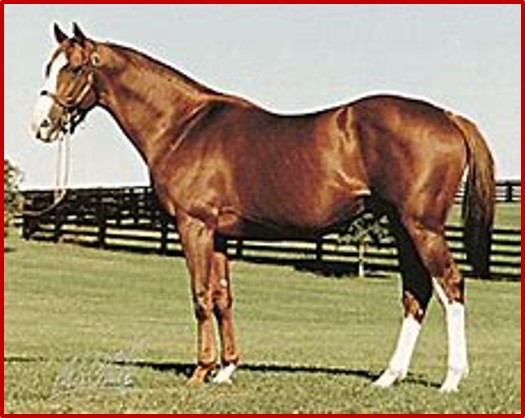
1983
Sunny’s Halo 2:02.20
(1980–2003)
The chestnut stallion is best known for winning the Kentucky Derby.
At age two but stress fractures in both front shins ended his season earlier than planned. Nonetheless, his performance earned him a 1982 Sovereign Award. In an attempt to heal the ankle problem, he was one of the first horses to be treated at the equine indoor swimming pool designed and built in the early 1970s by Jesse Reynolds.
He captured the Kentucky Derby against a very strong field that included future U.S. Racing Hall of Fame inductee Slew o’ Gold. It marked the first time in history that an Arkansas Derby winner won the Kentucky Derby. After the race, he developed a rash and a return of the sore ankle affected his performance.
He retired and had a very successful career standing stud.
1984
Swale 2:02.40
(1981–1984)
The dark brown stallion is best known for winning the Kentucky Derby and the Belmont Stakes in 1984. He died eight days after his win in the latter race.
On June 17, 1984, eight days after the Belmont Stakes, Swale collapsed and died en route to his stall following a bath.
A statement issued by the New Bolton Center of the University of Pennsylvania’s School of Veterinary Science, where extended tests had been run on samples and organs from Swale’s body, said that an area of fibrosis on his heart had been discovered in recent days. The statement said that “Dr. Helen Acland, the center’s head pathologist, had found a very small area of fibrosis below the aortic valve and that lesions of this type can produce an arrhythmia in the heart, which can be fatal.”
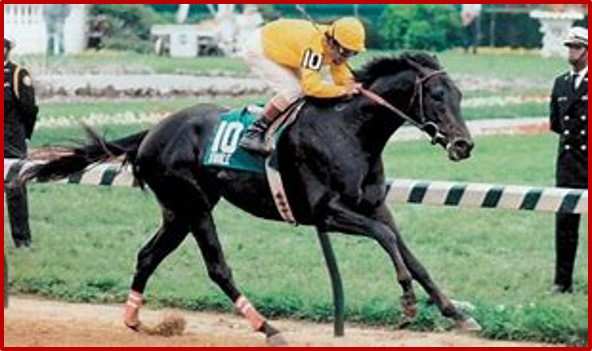
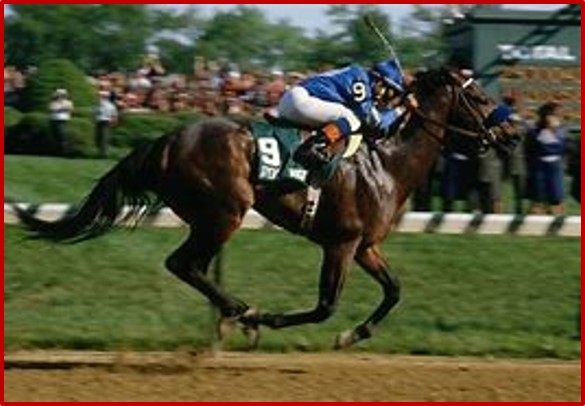
1985
Spend a Buck 2:02.20
(1982–2002)
The brown stallion is best known for winning the Kentucky Derby.
Spend a Buck won the Kentucky Derby by 5-3/4 lengths over Stephan’s Odyssey under jockey Angel Cordero Jr. His 2:00 1/5 time is the fourth fastest as of 2023. He paid $10.20, $5.40, and $3.40. It was his trainer Cam Gambolati’s first attempt to win the Derby, a feat not matched again until 2003 when Barclay Tagg saddled Funny Cide for his win.
Spend a Buck had a successful post-racing career standing stud. He died on November 24, 2002, at Haras Bage do Sul in Brazil following an anaphylactic reaction to penicillin.
1986
Ferdinand 2:02.80
(1983–2002)
The chestnut stallion is best known for winning the Kentucky Derby.
Much to the outrage of many horse racing enthusiasts, reports indicate that in 2002, Ferdinand was sent to slaughter in Japan with no fanfare or notice to previous owners. He likely became either pet food or steaks for human consumption. Ferdinand’s death was the catalyst for the Ferdinand Fee, an optional donation program to fund keeping old racehorses alive, and Friends of Ferdinand, a nonprofit group formed in 2005 with the goal of transitioning retired racehorses into second careers.
In September 2006, the United States House of Representatives approved H.R. 503, the American Horse Slaughter Prevention Act, which would ban the slaughter of horses in the United States. The bill did not make it out of committee in the Senate, however. In January 2007, the bill was reintroduced. As of 2012, the act has not been passed into law.
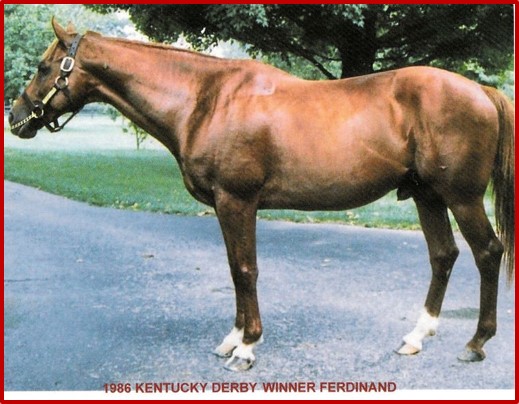
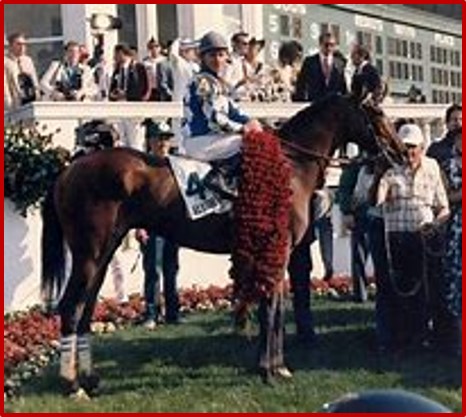
1987
Alysheba 2:03.40
(1984–2009)
The bay stallion is best known for winning the Kentucky Derby and Preakness Stakes.
In the Derby, he and jockey Chris McCarron were nearly knocked to the ground at the top of the stretch by Bet Twice. Alysheba recovered from the collision and won the Derby in a slow time of 2:034⁄5 for 11⁄4 miles. He then came back with another win in the Preakness Stakes, then attempted to become American racing’s 12th Triple Crown winner in the Belmont Stakes.
He retired to stud in the King of Saudi Arabia’s Royal Stables, before being returned home to the US.
On Friday, March 27, 2009, at 11:13 pm, Alysheba was euthanized “Due to a chronic degenerative spinal condition that led to ataxia and instability, Alysheba fell in his stall yesterday, injuring his right hind femur,” said Kathy Hopkins, the Horse Park’s director of equine operations. “Complicated by his advanced age, this trauma resulted in severe pain that did not respond to analgesic therapy. The resulting pain and suffering, and the inability to stand unaided, led to a joint decision for euthanasia.”
1988
Winning Colors 2:02.20
(1985–2008)
The grey mare, with a white blaze on her face, is best known for winning the Kentucky Derby.
For the Kentucky Derby, she was up against a stellar field of colts including Risen Star, Seeking the Gold, Forty Niner, Regal Classic, and co-favorite Private Terms. As was her habit, Winning Colors broke fast and raced to the lead. Although Forty Niner made a charge in the homestretch, she held him off to win by a neck.
In 1989 Winning Colors raced in her final campaign at age four and won two of her seven races and came ninth in the Breeders Cup Distaff, in a season hampered by breathing difficulties and surgery.
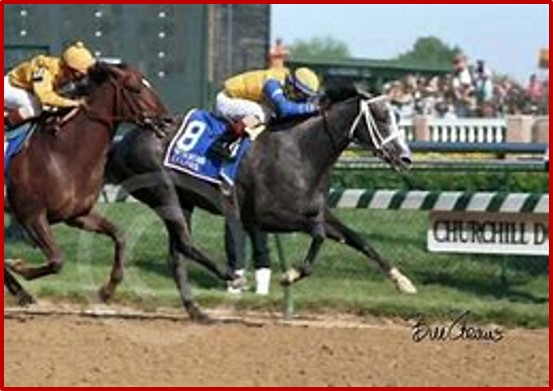
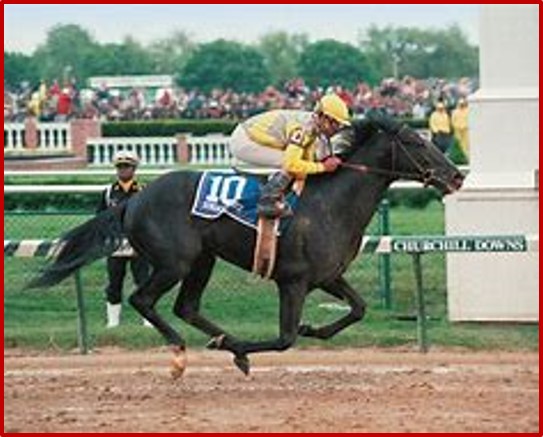
1989
Sunday Silence 2:05
(1985–2008)
The black stallion, with a white blaze on his face, is best known for winning the Kentucky Derby and the Preakness Stakes.
He was bred by Oak Cliff Thoroughbreds, Ltd. and escaped death twice: first as a weanling when he nearly died from a freak virus;[and later at age two, traveling in a van when the driver experienced a heart attack and the van flipped over.
Kentucky Derby day was a cold one at 44°, the coldest in 72 years, with rain creating a slow muddy track. After stalking the pace and making his move around the turn, Sunday Silence defeated Easy Goer by 2+1⁄2 lengths, in the slowest time (2:05) for a Kentucky Derby since 1958. Sunday Silence ducked in and out sharply throughout the stretch run, with his jockey switching from left and right-handed urging trying to keep him running straight. Even with ducking in and out, the champion Easy Goer was unable to make up ground.
The 1989 Preakness Stakes is one that continues to live in racing lore as one of the best races ever run, and one of the most iconic stretch duels. Easy Goer broke slow, and Sunday Silence was bumped at the start, then the pair settled in. After ¾ of a mile, Day guided Easy Goer to the front where Sunday Silence dug in and went with him. The legendary stretch duel was fought the entire length of the stretch, with neither Sunday Silence or Easy Goer giving an inch. Sunday Silence prevailed in the photo finish, with a finishing time of 1:53 4/5, the third fastest Preakness at the time.
1990
Unbridled 2:02
(1987–2001)
The bay stallion, with a broad white blaze, is best known for winning the Kentucky Derby.
He won the Kentucky Derby, by 3½ lengths. When Unbridled won the Derby, a network television camera in the Churchill Downs stands captured his trainer, Carl Nafzger, giving the horse’s elderly owner, Frances Genter, a stretch call because of her poor vision. Nafzger shouted, “He’s going to win! He’s going to win! Oh, Mrs. Genter, I love you!“
Unbridles retired to a very successful stud career.
In September 2001, Unbridled underwent two operations to be treated for intestinal issues. He underwent his first surgery on September 21, where three feet of his intestine was removed. Five days removed from the first surgery, he suffered a setback, and underwent a second surgery on September 26. Unbridled recovered again and was sent home to Claiborne Farm on October 8. On October 19, 2001, at 6:00 PM, Unbridled was euthanized at the clinic after a severe bout of colic, with his condition being deemed inoperable.
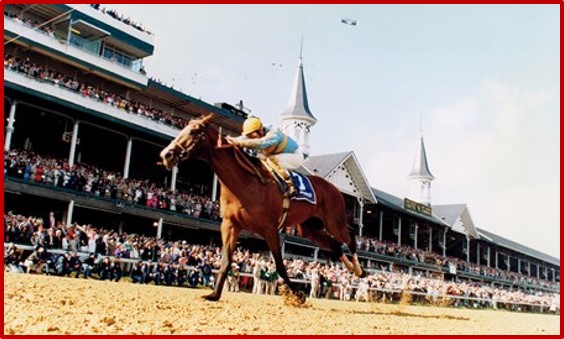
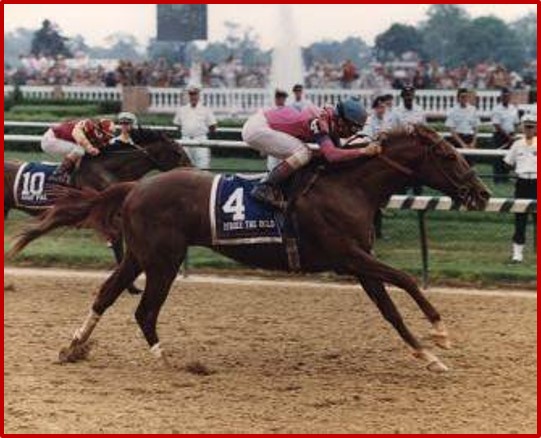
1991
Strike the Gold 2:03
(1988–2011)
The chestnut stallion is best known for winning the Kentucky Derby.
He was said to have barely survived birth and was born a “dummy foal”, which is a condition that creates a lack of oxygen to the brain. He was on oxygen for the first three days of his life. He was orphaned at four months when his mother, Majestic Gold, died of colic.
Strike the Gold, the son of the great sire Alydar, charged late and wide to win horse racing’s 117th Kentucky Derby.
The chestnut colt was 12th among 16 horses down the backside. He circled the field around the home turn and charged six-wide down the stretch to win the 1 -mile first leg of thoroughbred racing’s hallowed Triple Crown by 1 length.
He was retired to stud, then sold to a Turkish breeder.
1992
Lil E. Tee 2:03
(1989–2009)
The bay stallion is best known for winning the Kentucky Derby in possibly the biggest upset in the history of the Derby.
As a weanling, Lil E. Tee nearly died but was saved by emergency stomach surgery. Considered to have little racing potential, he was sold for $2,000 as a yearling. When he was two, his owner tried to sell him again but was rejected by an auction company that deemed the horse unsaleable. Lil E. Tee ended up in the hands of a Florida owner.
Starting in post position #10, Lil E. Tee got off to a clean start and was in tenth place after half a mile. Arazi, who had started on the far outside in post position #17, made an explosive move. ABC television announcer Dave Johnson exclaimed “Arazi is flying” as the colt went seven wide, sweeping past horse after horse to move into third place, tightly bunched with the leaders. Lil E. Tee followed Arazi, moving into 5th place. As they approached the home stretch, though, Arazi tired badly. Lil E. Tee made his move and soon caught the front-running Casual Lies to win the most prestigious race in America and $724,800.
On June 9, the colt’s racing season ended when he underwent arthroscopic surgery to remove bone chips from his front ankles.
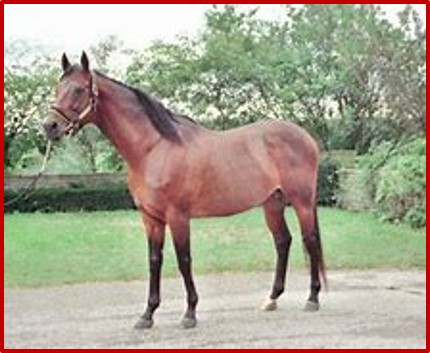
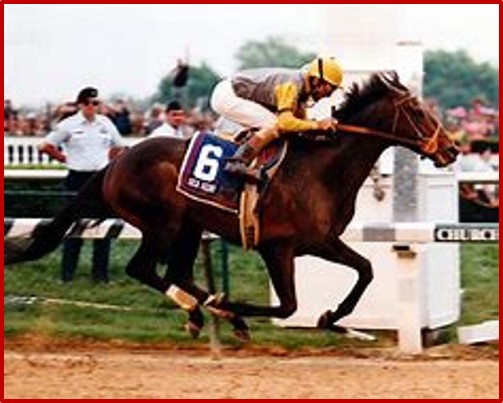
1993
Sea Hero 2:02.42
(1990–2019)
The bay stallion is best known for winning the Kentucky Derby.
Sea Hero was considered somewhat temperamental and had a habit of getting his tongue over the bit, forcing Miller (his 71-year-old trainer) to experiment with different equipment.
Fortunately catching a drying-out track labeled ‘good’ and also aided by a fast pace up front, Sea Hero made a bold move into contention around the far turn, seized control in upper stretch from front-running Secret Odds and bounded home by 5 3/4 lengths in a swift time of 1:34 4/5.
Sea Hero’s win is not only remembered for providing the beloved Mellon (owner) and Miller with a belated first Derby, but also by the heady ride the colt received by jockey Jerry Bailey. In between rivals just behind the leaders at the quarter pole, Bailey darted Sea Hero through an opening on the inside in upper stretch and the colt responded with a comfortable 2 1/2-length tally over a rallying Prairie Bayou.
1994
Go for Gin 2:03.72
(1991–2022)
The bay stallion is best known for winning the Kentucky Derby.
The 120th Kentucky Derby was held on May 7, 1994, over a sloppy track. Go for Gin entered the race at 9.10:1 odds, behind Holy Bull at 2.20, Brocco at 4.30, Tabasco Cat at 6.10, and Strodes Creek at 7.90. He started by ducking out, forcing Tabasco Cat into Brocco. By the 1/4 mile pole, Go for Gin moved up to second place behind Ulises. At the 1/2 mile pole, he led by half a length. As he entered the stretch, he increased the lead to four lengths. Strodes Creek and Blumin Affair both made late charges, closing the gap, but Go for Gin won by two lengths, Go for Gin placed second in the other legs of the Triple Crown.
In 1995, Go for Gin suffered a small tear of a tendon sheath in his left foreleg while working out at Belmont Park. This precipitated his retirement to stud. He died from heart failure on March 8, 2022, at the age of 30.
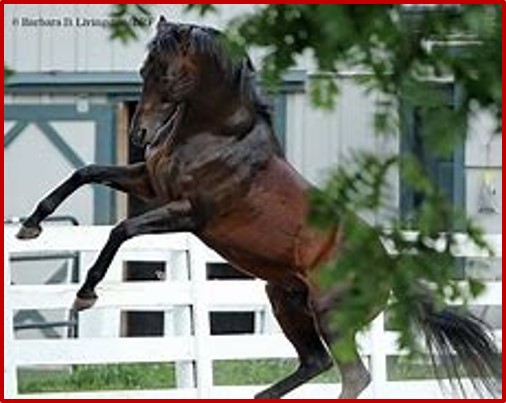
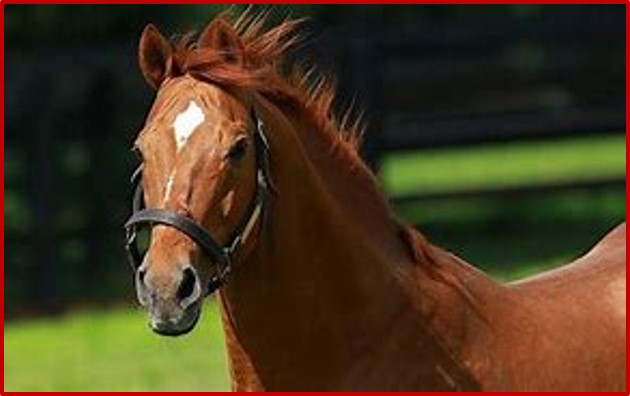
1995
Thunder Gulch 2:01.77
(1992–2018)
The chestnut stallion is best known for winning the Kentucky Derby and the Belmont Stakes.
At Churchill Downs, he left the starting gate at 25-1 odds in 1995 and won the Kentucky Derby in 2:01.2 from post 16.
Thunder Gulch was retired in the fall of his three-year-old campaign after finishing fifth to American Horse of the Year Cigar in a “much-anticipated showdown” for the Jockey Club Gold Cup. After the race, it was discovered that he had fractured his left front cannon bone.
He was retired to stud.
1996
Grindstone 2:01.06
(1992–2018)
The bay stallion is best known for winning the Kentucky Derby.
He won the Derby edging Cavonnier at the wire by a nose. He was jockey Jerry Bailey’s second Kentucky Derby winner, and the second in a row for trainer D. Wayne Lukas.
Grindstone was retired five days after his Kentucky Derby victory, when a bone chip was discovered in his knee. He was the first horse since Bubbling Over in 1926 to be retired immediately following a win in the Kentucky Derby.
He was retired to stud.
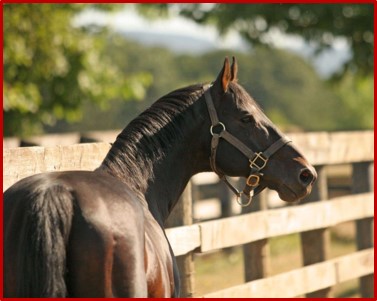
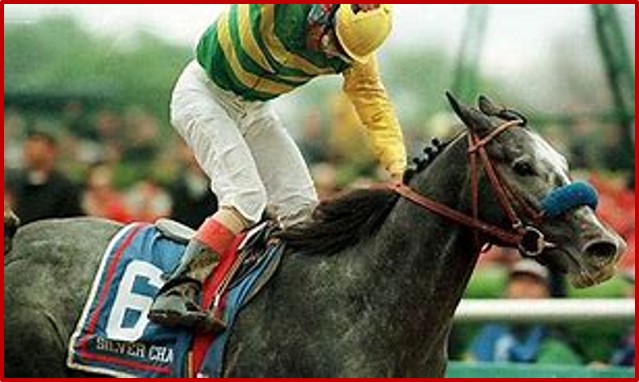
1997
Silver Charm 2:02.44
(1994–)
The grey stallion is best known for winning the Kentucky Derby and the Preakness Stakes.
Silver Charm drew the sixth post position out of a field of 13 and broke well at the starting gate. He came out between other horses going into the backstretch and took the lead with less than a furlong to go. He won the Derby, finishing a head in front of Captain Bodgit.
Silver Charm won the Preakness Stakes in the same manner, pulling ahead of Captain Bodgit and Free House just before the wire.
He was retired to stud, then sold to Japan and the buy-back clause was enacted and he retired to Old Friends Farm in Kentucky.
1998
Real Quiet 2:02.38
(1995–2010)
The bay stallion is best known for winning the Kentucky Derby and the Preakness Stakes. He was nicknamed “The Fish” by his trainer due to his narrow frame.
The fierce competition from rivals such as Victory Gallop added to the intensity of the prestigious event. In a heart-stopping finish down the stretch, Real Quiet surged ahead with grit and determination to claim victory by a narrow margin—securing his place in horse racing history as one of the most memorable champions ever seen at “the Run for Roses.”
Real Quiet died as the result of a paddock accident at Penn Ridge Farms in Harrisburg, Pa., according to the farm’s owner, Michael Jester.
Jester said that farm personnel found Real Quiet in his paddock, and that the horse had fractured several cervical vertebrae. Real Quiet was unable to get up and had to be euthanized.
Doctors at the New Bolton Center in Kennett Square, Pa., had determined on Tuesday that Real Quiet had fallen on his shoulder, driving the shoulder bone into the vertebra, Jester said. A search of his paddock did not turn up any marks in the grass or fencing to indicate how the injury had occurred, Jester said.
“He had to have reared up, slipped, and fell on his left shoulder, and that drove the bone into the back,” Jester said.
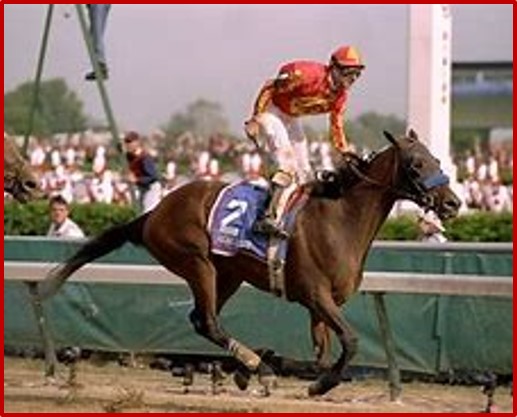
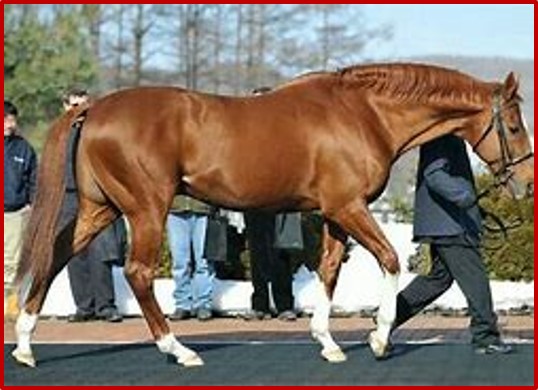
1999
Charismatic 2:03.29
(1996–2017)
The chestnut stallion is best known for winning the Kentucky Derby and the Preakness Stakes.
Charismatic was a 31-1 longshot in the Derby, facing a field of 18 other horses. Valhol set a slow early pace tracked by Cat Thief, who took over the lead rounding the final turn. Charismatic raced in mid-pack for the first three-quarters of a mile, then started closing ground rapidly on the leaders. He passed Cat Thief in deep stretch, then withstood a late charge from Menifee to win by a head.
Charismatic also won the Preakness Stakes 1½ lengths ahead of Menifee,
After winning the Derby and Preakness, Charismatic had the lead in the stretch of the Belmont Stakes before suddenly falling back and finishing third. He was quickly pulled up by jockey Chris Antley, who dismounted and cradled the horse’s fractured foreleg to prevent further injury. Charismatic’s foreleg had fractured in multiple places involving the cannon bone and sesamoids, and Antley’s actions probably saved his life by avoiding a more catastrophic injury. The horse was taken off the track in a van and underwent surgery the next day.
The footage of a tearful Antley holding Charismatic was selected by racing fans as the 1999 National Thoroughbred Racing Association Moment of the Year.
2000
Fusaichi Pegasus 2:01.12
(1997–2023)
The bay stallion is best known for winning the Kentucky Derby.
The colt was purchased as a yearling for $4 million by Fusao Sekiguchi, which is the highest price paid for a Kentucky Derby winner. His name is a combination of his owner’s name, “Fusao”, and the Japanese word for one, “ichi”, to mean No. 1 or the best; the second half of his name came from that of a winged horse in Greek mythology. He was nicknamed “Fu Peg“.
Fusaichi Pegasus won the 2000 Kentucky Derby in a time of 2:01.12 for the 11⁄4 mile distance. At the time, it was the seventh fastest time in Kentucky Derby history; by the time of his death, it was the tenth fastest time. He was the first favorite to win the Kentucky Derby since Spectacular Bid in 1979 and the first horse to win the Kentucky Derby without winning a race as a two-year-old since Proud Clarion in 1967.
He was retired to stud in Ireland, Australia, Chile, and Uruguay.
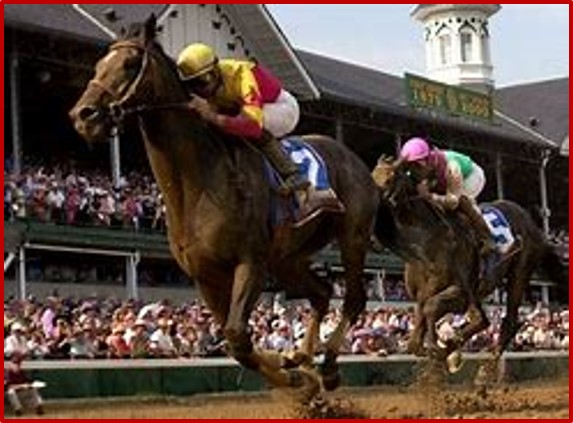
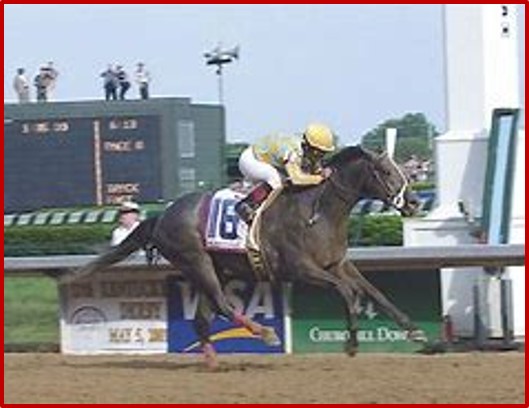
2001
Monarchos 1:59.97
(1998–2016)
The gray stallion is best known for winning the Kentucky Derby.
At Churchill Downs, Monarchos was the 10.5/1 fourth choice in the betting for the Derby. After being bumped at the start, he made steady progress on the outside and turned into the straight in sixth place. Chavez sent the gray colt to the lead a furlong from the finish, and Monarchos pulled clear to win by almost five lengths from Invisible Ink, with Congaree third and the favored Point Given fifth.
Monarchos’ winning time was 1:59.97 for 1+1⁄4 miles, becoming only the third horse in Derby history to finish the race in under 2 minutes, joining 1973 Triple Crown winner Secretariat, who ran 1:59 2⁄5, and his runner up, Sham, who ran 1:59 4⁄5 (at that time, the Derby was timed to the fifth of a second rather than to the hundredth of a second). As of 2022, no horse since Monarchos has broken the 2-minute barrier at the Derby.
He retired to stud. On October 22, 2016, Monarchos died after undergoing surgery to repair a ruptured intestine. He went into surgery after showing signs of internal distress the night before. He was 18 years old at the time of his death.[
2002
War Emblem 2:01.13
(1999–2020)
The dark bay stallion is best known for winning the Kentucky Derby and the Preakness Stakes. Often described as nearly black, he was registered as dark bay or brown colt with a white star.
Described as narcissistic, War Emblem was a temperamental horse who did not like people nor other horses: Bob Baffert nicknamed the colt ‘Hannibal Lecter’ for his habit of biting. He had a history of bone chips in his knees and ankles, which discouraged several potential buyers. He liked to race at the front of the field, but sometimes compromised his own chances by acting up in the starting gate.
Victor Espinoza was his jockey for the Derby, never having seen the horse until the morning of the race. War Emblem, who went off at 21-to-1 odds, took the early lead and sent sensible early fractions, then kicked away from the field in the stretch.
He was sold to a Japanese racing family to stand stud. He was resold to Old Friends Equine Retirement where he was gelded. War Emblem was found dead in his paddock at the age of 21. The cause of death was later found to be a ruptured small intestine.[
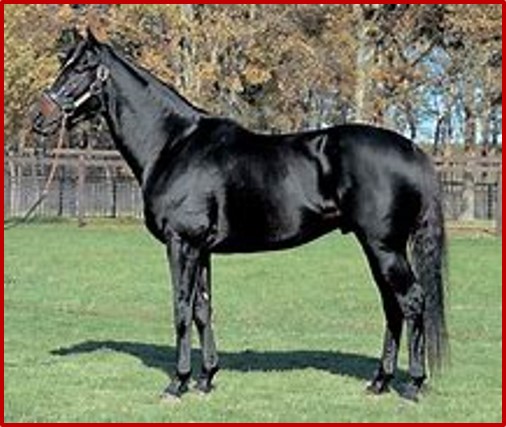
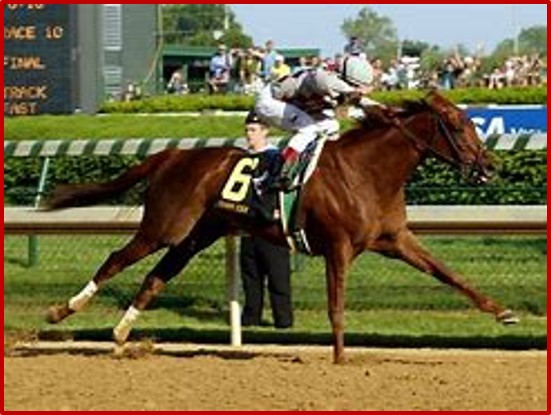
2003
Funny Cide 2:01.19
(2000–2023)
The chestnut gelding is best known for winning the Kentucky Derby and the Preakness Stakes. He is also the first New York bred horse to win.
Bumped again at the start, Funny Cide tracked the early pace set by Peace Rules, and moved to the lead heading into the stretch. Empire Maker then started closing fast but Funny Cide was able to hold on by 1+1⁄2 lengths. “I hit him and he kept digging and digging and he did it,” said Santos. “It was New York pride.” Funny Cide’s time of 2:01.19 was the tenth fastest time in Kentucky Derby history.
After retirement, Funny Cide’s future career would be as a stable pony in the mornings, accompanying younger horses in their training. “He’ll still be doing what he’s done the past five years, but he just won’t be racing in the afternoon“.
Funny Cide died due to complications of colic on July 16, 2023, at the age of 23. He resided at the Kentucky Horse Park for the last 15 years of his life.
2004
Smarty Jones 2:04.06
(2001–)
The chestnut stallion is best known for winning the Kentucky Derby and the Preakness Stakes.
On a rainy May 1, 2004, Smarty Jones entered the Kentucky Derby, where he became the post time favorite, and won. He became the first unbeaten winner of the race since Seattle Slew in 1977. Servis and Elliott became the first trainer/jockey combination in 25 years to win the Kentucky Derby in their debut appearance. Smarty Jones won the race by 2+3⁄4 lengths
He won the Preakness Stakes by an amazing 11 ½ lengths.
He is standing stud at his farm in Pennsylvania.
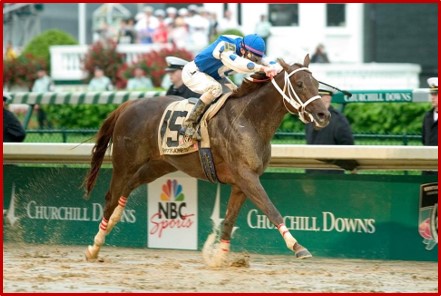

2005
Giacomo 2:02.75
(2002–)
The gray stallion is best known for winning the Kentucky Derby at 50-1 odds. The horse, named for the rock star Sting’s 9-year-old son, was ridden by Mike Smith, who, at long last, grabbed his first Derby victory in his 12th attempt.
Giacomo, ridden by Mike E. Smith, won the 2005 Kentucky Derby in a time of 2:02.75. At odds of 50–1, Giacomo stands as tied, with Mine That Bird in 2009, for the fourth-biggest longshot ever to win the Derby, trailing only Country House (horse), at 65–1 in 2019, Rich Strike at 80-1 in 2022, and Donerail, who went off at 91–1 in 1913.
He retired to stud at a farm in Oregon.
2006
Barbaro 2:01.36
(2003–2007)
The bay stallion is best known for winning the Kentucky Derby but shattered his leg two weeks later in the Preakness Stakes which ended his racing career and eventually led to the decision to euthanize him.
Barbaro’s Preakness Stakes began with a false start when he broke from the starting gate prematurely. Barbaro was deemed fit upon being reloaded into the gate. As the restarted race began, Barbaro broke cleanly, but suffered a catastrophic injury as the horses passed the grandstand shortly after the start.
Barbaro broke his right hind leg in more than 20 places: a broken cannon bone above the pastern, a broken sesamoid bone behind the fetlock and a broken long pastern bone below the fetlock. The fetlock joint was dislocated, and his foot was left dangling loosely. Veteran jockey Edgar Prado immediately pulled Barbaro up and brought him to a gentle stop. He dismounted and leaned his shoulder into the horse’s shoulder to support Barbaro until track attendants could arrive. He underwent numerous surgeries but ultimately suffered numerous complications.
In 2006, a Limited Edition Ty Beanie Babies Barbaro Beanie plushie was released. The plushie wears Barbaro’s No. 8 on a pink saddle cloth.
In 2007, Breyer Animal Creations released a Barbaro model that includes a Certificate of Authenticity from his owners, jockey, and main doctor at the New Bolton Center.
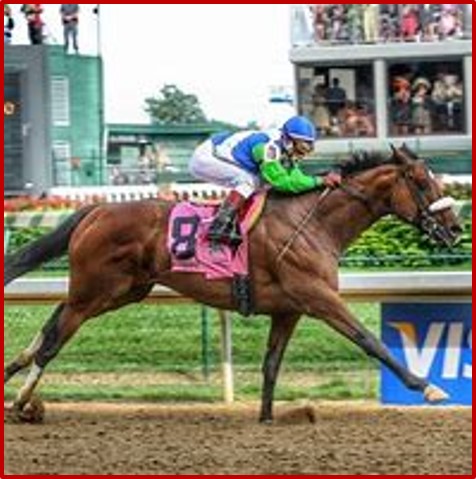
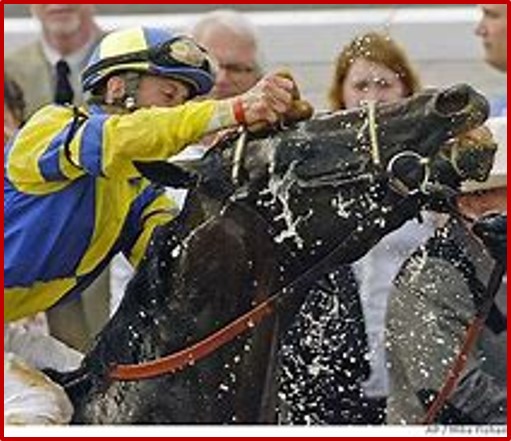
2007
Street Sense 2:02.17
(2004–)
The dark bay stallion is best known for winning the Kentucky Derby.
Street Sense rallied from a second-to-last deficit to beat Hard Spun by 21⁄2 lengths. This victory made him the first winner of the Breeders’ Cup Juvenile ever to win the Kentucky Derby and the first U.S. Champion Two-Year-Old Colt to win the Derby since Spectacular Bid in 1979.
He is retired to stand stud.
2008
Big Brown 2:01.82
(2004–)
The bay stallion is best known for winning the Kentucky Derby and the Preakness Stakes.
In just his fourth race, Big Brown was the 2–1 favorite in the Derby. He started from the far outside post position 20, but neither that, nor his lack of experience seemed to be a problem. At the break, Desormeaux did not push Big Brown, concentrating instead on getting good position on the first turn while settling instead behind the leaders. “He was just galloping, floppy-eared, off the bridle, cruising,” said Desormeaux. On the far turn, Desormeaux urged the horse and Big Brown responded with a burst of speed that swept him to the lead. He won by 4+3⁄4 lengths over filly Eight Belles, who was euthanized after breaking both front fetlocks during the post-race cool-down. The last horse to win the Kentucky Derby from post position 20 was Clyde Van Dusen in 1929.
He stands stud in retirement.
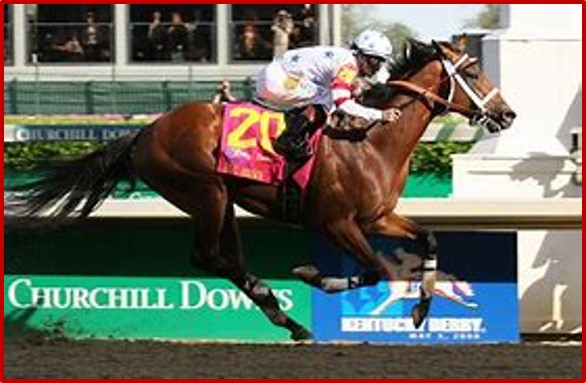
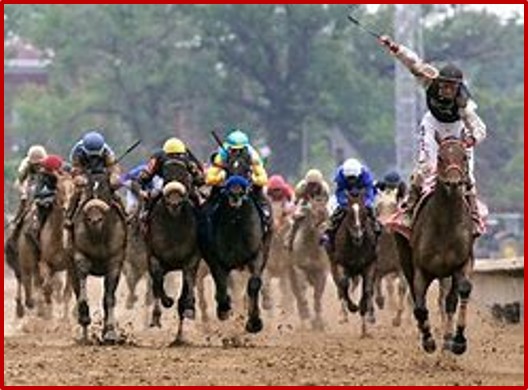
2009
Mine That Bird 2:02.66
(2006–)
The bay gelding is best known for winning the Kentucky Derby. His odds were 50-1.
Following overnight rain, the Churchill Downs natural dirt track was rated as “sloppy“. Ridden by Calvin Borel, Mine That Bird had trouble out of the starting gate and was left about eight lengths behind the rest of the field. By the time the pack of horses was running down the backstretch, Mine That Bird was so far back that NBC’s announcer Tom Durkin at first missed seeing him.
Calvin Borel, using the ground-saving, rail-skimming riding technique that won him the 2007 Derby with Street Sense, charged past horses along the backstretch and at the turn for home moved into contention. Borel kept Mine That Bird on the rail, leaving it to go around just one tiring horse before ducking back onto the rail, where he exploded past Pioneer of the Nile and Musket Man so fast on the inside that Durkin, who was focused on the other two horses, did not see “Bird” come through until he was already three lengths in the lead. Mine That Bird pulled away to win by 63⁄4 lengths for the longest margin of victory in over 60 years.
2010
Super Saver 2:04.45
(2008–)
The bay stallion is best known for winning the Kentucky Derby.
Super Saver completed 1 1/4 miles on a sloppy track in 2:04.45. It had rained almost the entire day, but, appropriately, the sun came out just as the horses came on the track for the post parade, when the band struck up “My Old Kentucky Home.”
Super Saver hugged the rail the whole way while racing in the first flight of horses behind the runaway leaders, Conveyance and Sidney’s Candy. On the far turn, Super Saver came around Conveyance and knifed between him and Noble’s Promise, who had briefly taken the lead. Super Saver kicked clear passing the furlong pole while racing along the inside. He won in the field of 20 horses.
Super Saver retired to stand stud and has travelled to Australia, Argentina, and Turkey.
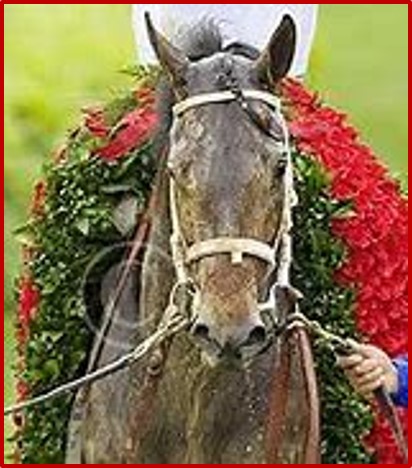
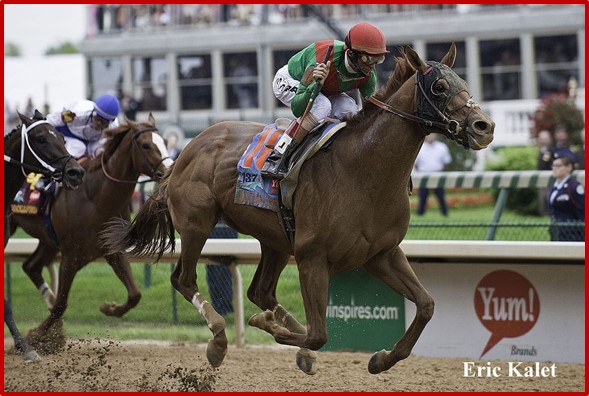
2011
Animal Kingdom 2:02.04
(2008–)
The chestnut stallion is best known for winning the Kentucky Derby.
On the morning of the Kentucky Derby, his morning-line odds were 30:1. By post time, he was 21:1 in his first race on dirt. Animal Kingdom drew post 16 and was ridden to a 2+3⁄4 length victory in the Derby by jockey John R. Velazquez, who was originally scheduled to ride the early favorite and American Champion Two-Year-Old Colt, Uncle Mo. Uncle Mo was scratched due to a gastrointestinal illness on the Friday before the race, and Velazquez (who was discovered by his agent Angel Cordero) replaced injured rider Robby Albarado on Animal Kingdom. This was the first time Velazquez rode Animal Kingdom, and the jockey’s first Kentucky Derby win in 13 tries.
Animal Kingdom is retired and stands at Stud.
2012
I’ll Have Another 2:01.83
(2009–)
The chestnut stallion is best known for winning the Kentucky Derby and the Preakness Stakes.
I’ll Have Another started at odds of 15–1 in what was considered an unusually strong field. I’ll Have Another produced a strong finish to catch the front-running Bodemeister in the closing stages and win by one and a half lengths. He is the first horse in the history of the Derby to have won from post position 19. It was the Derby debut for his 25-year-old jockey Mario Gutierrez, who had not previously ridden in any of the Triple Crown races. After the race, Gutierrez described I’ll Have Another as “an amazing horse”, and said that “from the first time I met him, I knew he was the one”.
In the Preakness Stakes I’ll Have Another was sent off at odds of 3–1 with Bodemeister starting favorite at 8–5. Gutierrez settled the colt in fourth place as Bodemeister set the pace from Creative Cause. On the turn into the straight, I’ll Have Another passed Creative Cause to move into second place and caught Bodemeister in the final strides to win by a neck.
A tendon injury ended his hopes of a Triple Crown.
He retired to stud in Japan, then moved to a breeding barn in California, the ultimately was donated to Old Friends Equine in Kentucky.
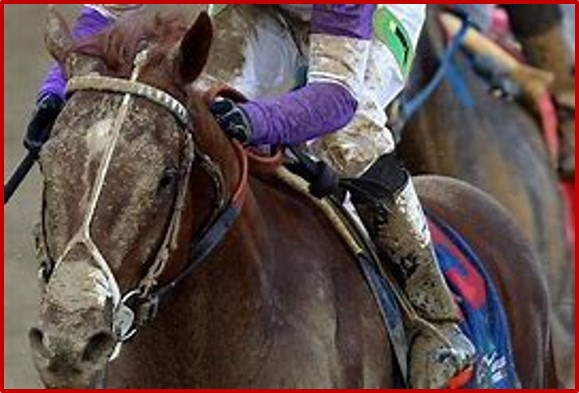
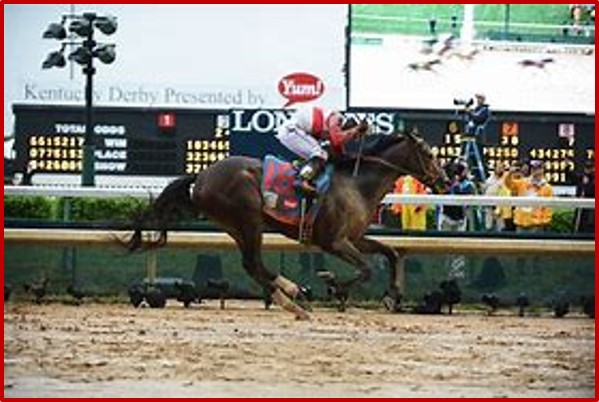
2013
Orb 2:02.89
(2010–)
The bay stallion is best known for winning the Kentucky Derby.
Orb, ridden by Joel Rosario, started as the favorite for the 139th Kentucky Derby. Rosario positioned the colt toward the rear of the 19-horse field in the early stages as the outsider Palace Malice set a fast pace. From half distance, Orb began to make progress on the outside and turned into the straight just behind the leaders. Normandy Invasion took the lead from Palace Malice, but Orb continued to make ground in the center of the sloppy track. The favorite took the lead 1/16 of a mile from home and pulled away to win by 2 1/2 lengths from Golden Soul. McGaughey, who had just won the race for the first time, said, “I’ve always dreamed of this day and it finally came… I’m thrilled for the people who put in so much time on this horse, and of course I’m thrilled for me.“
Since winning the Kentucky Derby in 2013, Orb has been referenced in several episodes of the Maximum Fun podcast My Brother, My Brother and Me. Orb, as part of a running gag, is described as a literal orb, an alien construction masquerading as a horse in order to breed with “Earth horse-women”.
He retired to stand stud.
2014
California Chrome 2:03.66
(2011–)
The chestnut stallion with a white blaze is best known for winning the Kentucky Derby and the Preakness Stakes.
He was flown in from California, his first time on a plane, and traveled quietly. Once the plane landed, however, his travel idiosyncrasy was discovered by the waiting press when he refused to be unloaded until he was turned around and backed down the ramp; Alan Sherman explained later that this was also his typical manner of egress from ground-based transportation.
In the race, California Chrome had a clean start and could have taken the lead, but Espinoza kept him behind two speed horses and only moved him to the front at the final turn when other horses began to tire. In the homestretch, he opened up a lead of five lengths before Espinoza eased him the last 70 yards of the race, narrowing his winning margin to 1+3⁄4 lengths. Sherman later explained that Espinoza slowing the colt down at the finish was “saving something for the next one”, a reference to the Preakness Stakes to come two weeks later.
He retired to stand stud and has a following of “Chromies” who love his Cinderella Story.
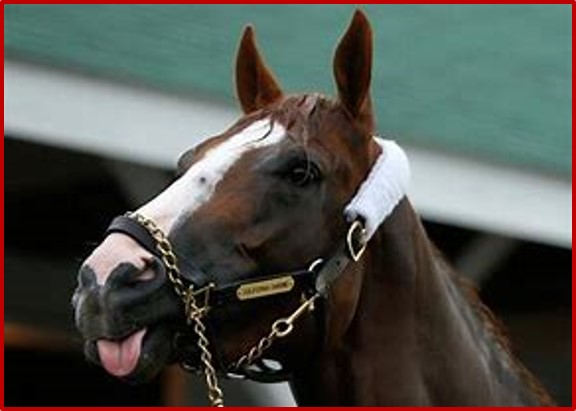
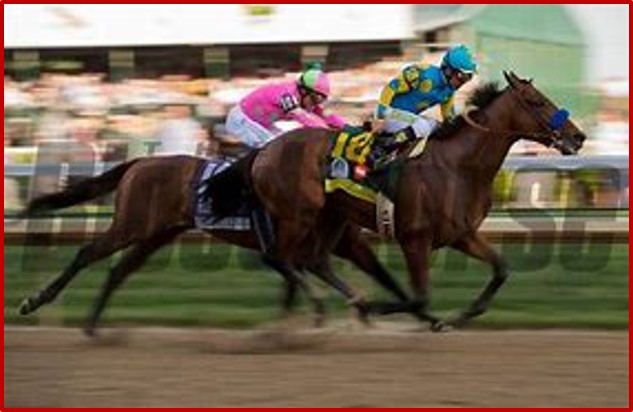
2015
American Pharoah 2:03.02
(2012–)
The bay stallion with a faint star on his forehead is best known for being the 12th Triple Crown winner in history.
American Pharoah started as the 2.9–1 favorite in an eighteen-runner field The crowd surrounding the horse during the walk-over from the barns to the paddock upset American Pharoah, and several grooms were required to keep him under control. He continued to misbehave until he was loaded into the starting gate.
Espinoza positioned the colt in third place early in the race as Dortmund took the lead, followed closely by Firing Line. The three remained ahead of the pack throughout the race, and broke clear of their rivals entering the straightaway with American Pharoah making a forward move on the outside.
He was retired to stand stud and had multiple owners and travelled extensively.
2016
Nyquist 2:01.31
(2013–)
The bay stallion is best known for winning the Kentucky Derby.
For the Kentucky Derby, Nyquist drew post position 13 in a full field of 20. Going off as the 2–1 favorite, Nyquist broke well and sprinted to the lead to establish position close to the rail. Gutierrez then eased back on the colt while Danzing Candy rushed up on the outside to set a very fast pace. Gun Runner tracked in third and then moved to the lead when Danzing Candy started to tire around the far turn. Nyquist responded and drew away from the field at the head of the stretch, then withstood a sustained drive by Exaggerator to win by 1+1⁄4 lengths.
Nyquist retired to stand stud. He had colic surgery in 2016 and recovered well.
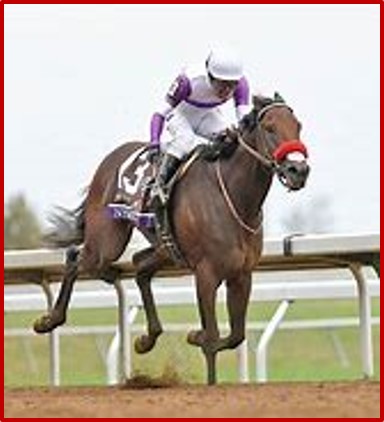
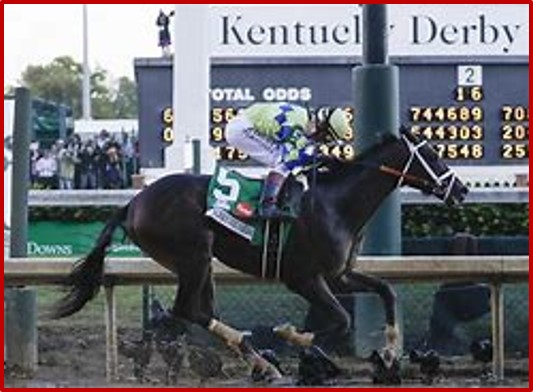
2017
Always Dreaming 2:03.59
(2014–)
The dark bay stallion is best known for winning the Kentucky Derby.
The Derby was held on a track that was officially labelled as wet fast. After drawing post position five in a full field of 20 horses, Always Dreaming broke well and settled just behind the early leader State of Honor with good position on the rail. After half a mile, jockey John R. Velazquez moved him to the outside of State of Honor and the two raced together into the far turn. When other horses then started to challenge for the lead, Always Dreaming quickly responded by drawing away and opening a lead of several lengths in the stretch. Longshot Lookin At Lee made a late run to finish second, but Always Dreaming was never threatened, winning by 2+3⁄4 lengths. After the race, Velazquez said, “I got a good position with him early and then he relaxed. When we hit the quarter pole, I asked him and he responded. He did it himself from there.“
He retired as a four year old to stand stud.
2018
Justify 2:04.20
(2015–)
The chestnut stallion with a large white blaze is best known for winning the Triple Crown.
The Derby was held on a rainy day at Churchill Downs. Although the surface had been sealed earlier in the day to minimize the effect of the rain on the footing, the track condition was still labeled as sloppy. Justify broke well and used his early speed to establish good position near the rail going into the first turn, running a length behind Promises Fulfilled. These two maintained their position for the first three-quarters of a mile. Going into the final turn, Promises Fulfilled dropped back while first Bolt d’Oro and then Good Magic were put to a drive. Justify responded to the challenge and opened up a lead of 1+1⁄2 lengths at the top of the stretch, widening to 2+1⁄2 lengths at the finish line.
Justify came out of the race almost untouched by the mud due to his front-running style. The day after however, he appeared to be somewhat lame in his left hind leg, the sensitivity was later determined to have been caused by a heel bruise. To protect the heel, Justify was shod with a three-quarter horseshoe before he resumed galloping on May 10.
After winning the Triple Crown, Justify was retired due an injury in his left front leg. He now stands stud.
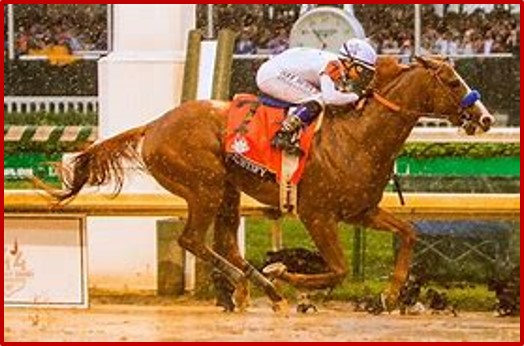
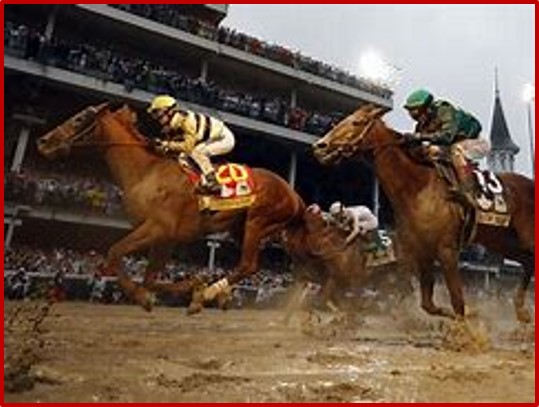
2019
Country House 2:03.93
(2016–)
The chestnut stallion is best known for winning the Kentucky Derby.
In the Derby, Maximum Security crossed the finish line first, but was judged to have impeded War of Will and Long Range Toddy when he swerved into their path, causing them to check strides. As a result, Maximum Security was disqualified, and Country House, who had crossed the finish line second, was declared the winner.
On May 7, Country House was ruled out of running in the 2019 Preakness Stakes, due to his trainer detecting a virus. This marked the first time the Kentucky Derby winner did not race in the Preakness Stakes since 1996.
Country House went on to develop a series of ailments that led to his retirement. Accordingly, he was first “diagnosed with proximal suspensory ligament desmitis on both front fetlocks” in June. Country House then experienced complications, leading to his hospitalization at Rood and Riddle Equine Hospital on July 1 for an infection on his lower right fore. Because the right fore was not load bearing during his recovery from the infection, his left fore had to bear the extra weight and developed laminitis. Over the next several months, the laminitis was stabilized and Country House was then turned out to pasture.
He would never race again was is now standing at stud.
2020
Authentic 2:00.61
(2017–)
The bay stallion with a white blaze is best known for winning the Kentucky Derby.
Authentic, ridden by Velazquez drew the outside post, saddle cloth 18, making the start critical because he would either have to run hard to get early position or run further than most other horses because he was on the outside. Authentic started slow, whereas Tiz the Law got off to a perfect start and went into his usual stalker position. Velazquez urged Authentic to the lead, running a fast first quarter while being carried four wide around the first turn. Then Velazquez slowed the pace. Tiz the Law began to make his move on the far turn. The two horses ran head-to-head into the top of the stretch and Tiz the Law looked to have the advantage. However, Authentic responded to the challenge and drew off to win by 1+1⁄4 lengths.
Velazquez said he had not been concerned about the pre-race talk regarding Authentic’s lack of stamina, noting instead how the colt had responded when asked to run at the head of the stretch. “That’s all you ask for a horse, that when you get after him and they give you everything they can, and he did. I mean, he responded. Every time I asked him for more, he gave more.”
After the race, when Authentic was in the winner’s circle, he started to wheel about, apparently distracted by the ribbons on the winner’s blanket of roses. He knocked over a couple of people including his trainer Baffert.
Authentic retired to stand stud.
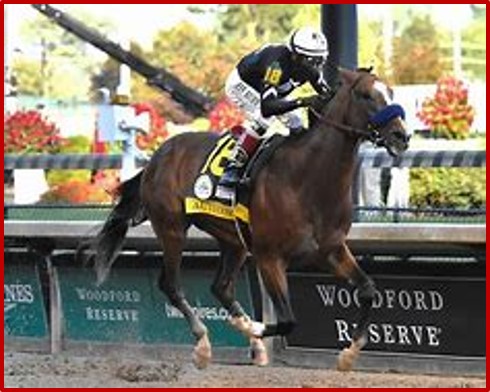
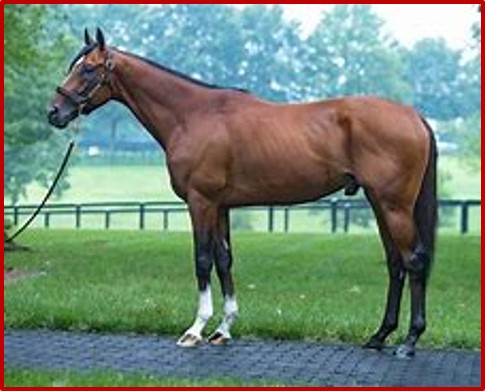
2021
Mandaloun 2:01.02
(2018–)
The bay stallion is best known for winning the Kentucky Derby. The horse is named for a mandaloun, “a type of mullioned (or decorative partition) window from traditional Lebanese architecture”
Mandaloun started well and was fourth. He slowly moved up and challenged the leader, Medina Spirit. Behind him, Hot Rod Charlie and his stablemate Essential Quality began to move up. There were four horses in the stretch. Medina Spirit won by +1⁄2 length, Mandaloun was second with +1⁄2 length, third was Hot Rod Charlie with a head to stablemate Essential Quality. 5th placed O Besos was 4+1⁄2 lengths behind them.
After the Kentucky Derby, an investigation was launched because of doping issues with Medina Spirit, who died on December 6, 2021; there was also an investigation of his trainer, Bob Baffert. On February 21, 2022, upon the disqualification of Medina Spirit, Mandaloun was awarded first place in the 2021 Kentucky Derby.
In 2022, Mandaloun was retired from racing and would stand stud.
2022
Rich Strike 2:02.61
(2019–)
The chestnut stallion with a white blaze and two white socks on his hind legs is best known for winning the Kentucky Derby.
Rich Strike was short of the points required to qualify for the race. However, the last-minute scratch of another horse, Ethereal Road, allowed him to draw into the Derby, and minutes later, Reed took another phone call from chief steward Barbara Borden, asking him if he wanted to run Rich Strike in the Derby. Reed joked that the last-minute notification left him needing cardiopulmonary resuscitation, as he had just been about to enter Rich Strike in another race. “He’s never been better; he loves this track,” said Reed. “All week long, I was like, ‘He just gets better every day.’ He’s so happy right now. It’s just a blessing to be able to run.”
The field for the Derby was one of the deepest in recent memory. Rich Strike was overlooked at odds of 80:1. He broke well from the outside post position and settled into the back of the pack where he was in eighteenth place after the first half-mile, 17 lengths behind the leaders. During this time Summer is Tomorrow and Crown Pride battled up front starting the race off with an extremely fast pace. He started his move on the final turn while weaving through traffic, first shifting out four horses wide of the rail then back towards the rail. In the stretch, he was checked briefly by a tiring horse but again found racing room and launched a sustained drive to the inside of Epicenter. He drew clear in the final strides to win by three-quarters of a length. A shocked Reed collapsed in the paddock.
It was the first graded stakes win for jockey Sonny Leon, who was commended by Reed for an excellent ride. “You know we had a difficult post but I know the horse,” said Leon. “I didn’t know if he could win but I had a good feeling with him. I had to wait until the stretch and that’s what I did. I waited and then the rail opened up. I wasn’t nervous, I was excited. Nobody knows my horse like I know my horse.”
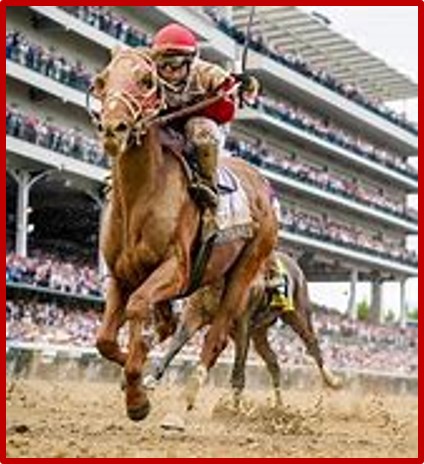
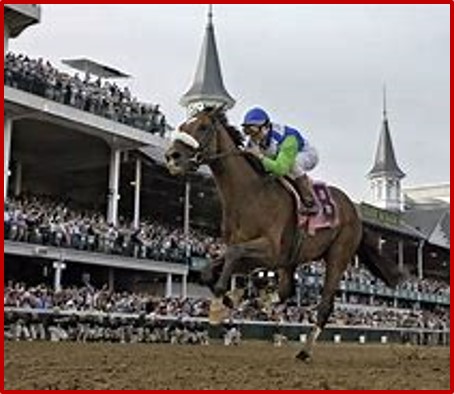
2023
Mage 2:01.57
(2020–)
The chestnut stallion is best known for winning the Kentucky Derby.
Mage broke slowly in the Derby as he did in his previous two close losing efforts. Jockey Javier Castellano allowed his mount to settle toward the back of the field of 18. A fast pace proved to his benefit, with fractions of :22.35, :45.73, and 1:10.11 set by frontrunners Verifying, Kingsbarns, and Reincarnate. Castellano picked his opportunities to advance and had Mage up to sixth by the mile marker. Down the lane, the lightly raced colt caught leader Two Phil’s to win by a length
At post-time, Mage went off at 15–1 to win. He joins Regret (1915), Big Brown (2008), and Justify (2018) as the only Derby winners who had only three prior starts. Mage, Justify, and Apollo (1882) are the only horses to win the Derby without having raced as two-year-olds.
He is still racing as a four year old.
This presentation was created from the combined research of numerous websites,
some of which are listed below.




